

The U.S. is a large country and many areas have their own culture, customs, and health habits that can impact local public health outcomes. Residents in many parts of the country struggle to get adequate preventive care, while others suffer from unhealthy diets and poor exercise habits that can drastically shorten life spans.
For instance, the premature mortality rate, which measures deaths of people before the age of 75, is just 196 deaths per 100,000 residents in the San Jose-Sunnyvale-Santa Clara, California metropolitan area. Yet in parts of the Southeastern United States, the premature mortality rate is over 500 deaths per 100,000 residents.
It can be difficult for some communities to improve the health of their residents. There are a number of important factors affecting the health of Americans at a city, county, and national level. Justin Rivas, an associate researcher and community coach with County Health Rankings & Roadmaps, said that “Social and economic factors have the largest weight on poor health. That’s things like education, employment, income, family and social support, and community safety.”
To determine the healthiest city in every state, 24/7 Wall St. reviewed health indicators and health outcomes for each metro area in the United States. We constructed an index from these factors to determine the overall health of the residents in each metropolitan area.
Click here to see the healthiest city in each state.
Click here to see our detailed findings and methodology.

1. Alabama: Daphne-Fairhope-Foley
> Premature death rate: 351.3 per 100,000
> Adult obesity rate: 29.3%
> Rate of uninsured people under 65: 11.7%
> Median household income: $56,732
All 12 metropolitan statistical areas in Alabama are less healthy than the average U.S. metropolitan statistical area, but the Daphne-Fairhope-Foley area is the healthiest among all of them. Its premature death rate of 351 per 100,000 residents makes it the only place in Alabama with a premature death rate below the U.S. average of 363. Daphne area adults are also the least likely to be obese in Alabama. Only one other metro area in Alabama has an obesity rate below 32.0%. Obesity has a strong link to many negative health outcomes, such as heart attacks, strokes, and certain types of cancer.
Daphne area residents are the least likely to live in poverty, likely contributing to healthier outcomes. Some 11.4% of area residents live below the poverty line, which is less than the 14.0% national rate. Poverty is closely tied to negative health outcomes, as people living below the poverty line often struggle to afford prescriptions and other treatments to maintain their health. Those in lower income neighborhoods can also struggle to find nutritious food.
[in-text-ad]

2. Alaska: Fairbanks
> Premature death rate: 330.3 per 100,000
> Adult obesity rate: 28.9%
> Rate of uninsured people under 65: 11.6%
> Median household income: $77,328
Alaska has just two metro areas — Fairbanks and Anchorage — and both are among the healthier places in the country. Fairbanks is the healthier of the two areas. For every 100,000 residents of Fairbanks, 330 died prematurely — well below the U.S. rate of 363 per 100,000. Some 13.2% of Fairbanks adults reported being in either fair or poor health, the lowest rate in the state and well below the 16.0% U.S. rate. The metro area’s adult residents also reported just 3.0 mentally unhealthy days in the last month — nearly the lowest in the entire country.
Healthy habits are often established in childhood and that is made all the easier when children live in households that are not impoverished. In Fairbanks, just 9.9% of children live in poverty — the lowest rate of any U.S. metro area. The median household income in the Fairbanks area is $77,328, nearly $20,000 higher than the U.S. median of $57,617.
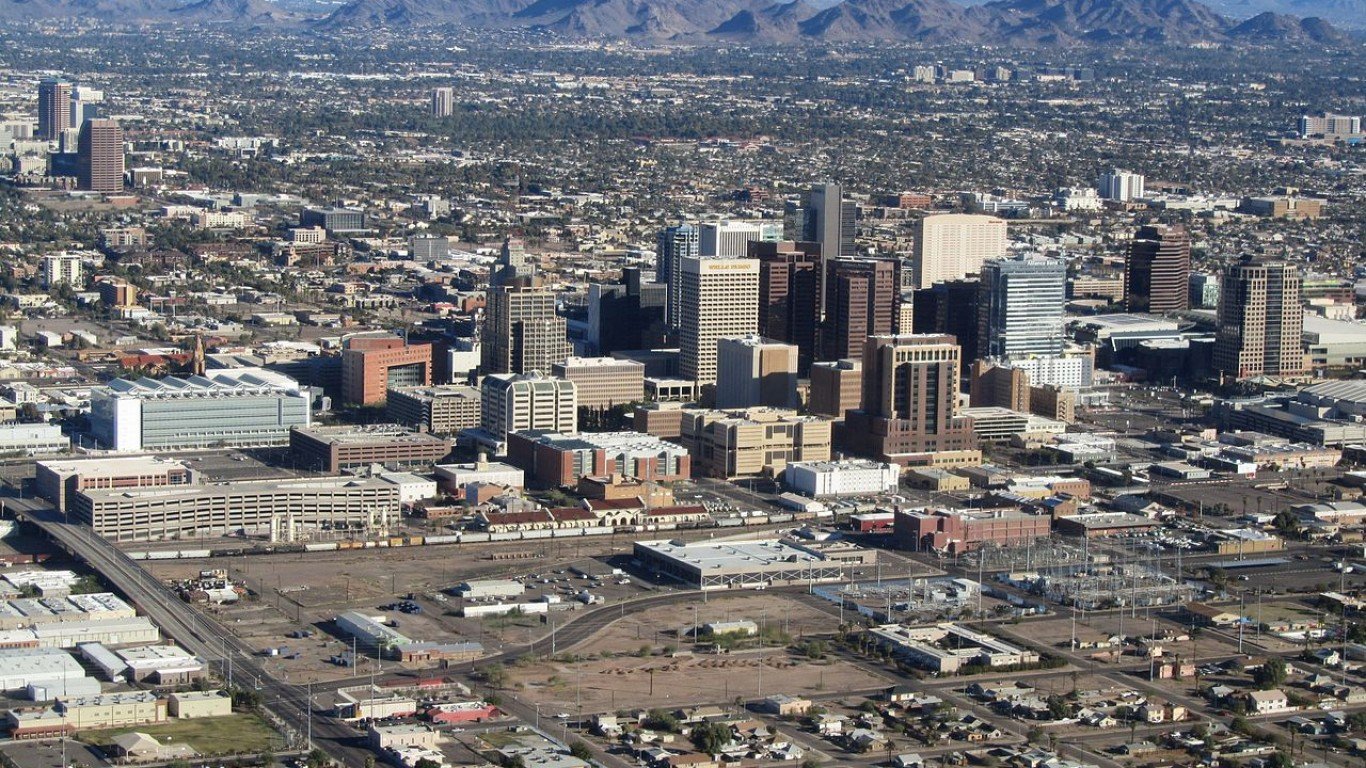
3. Arizona: Phoenix-Mesa-Scottsdale
> Premature death rate: 303.5 per 100,000
> Adult obesity rate: 26.9%
> Rate of uninsured people under 65: 13.4%
> Median household income: $58,075
Physical activity is crucial to maintaining long-term health. People in the Phoenix area have more access to places where they can exercise than residents of any other part of Arizona. Some 90.8% of Phoenix-Mesa-Scottsdale residents have somewhere to exercise. That is the highest rate of anywhere in the state and one of the higher rates in the U.S. More than 80% of area adults reported getting at least some physical activity in their leisure time, one of the higher rates in the country.
Phoenix area adults also tend to avoid smoking more than anywhere else in the state. Just 13.9% of adults smoke, compared to 17.0% of adults nationwide. These factors and more may contribute to the fact that the Phoenix area has the lowest premature age-adjusted mortality rate in Arizona. Some 304 per 100,000 Phoenix residents die prematurely, well below the Arizona metro area average and the U.S. average of 363.
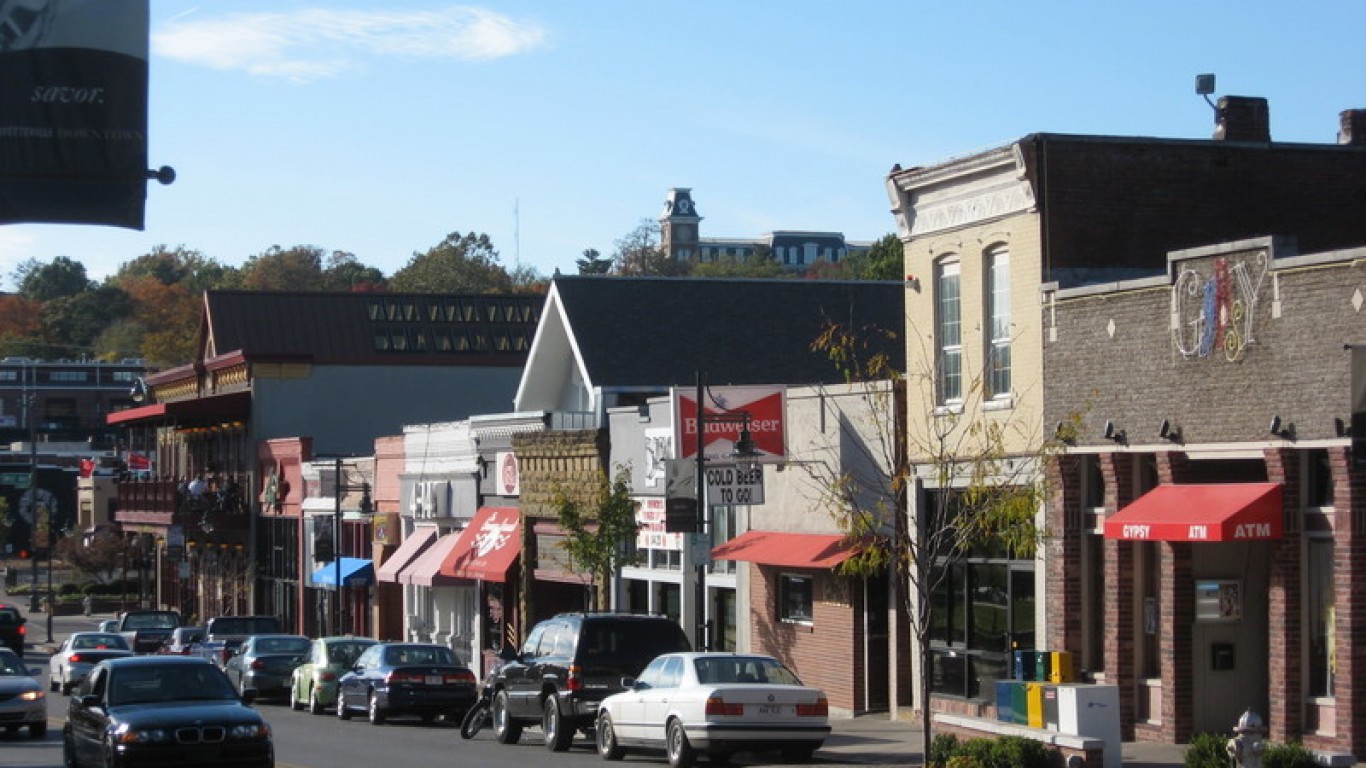
4. Arkansas: Fayetteville-Springdale-Rogers
> Premature death rate: 356.3 per 100,000
> Adult obesity rate: 30.4%
> Rate of uninsured people under 65: 12.8%
> Median household income: $51,848
Arkansas metropolitan areas tend to lag behind much of the rest of the country in many key health indicators. The Fayetteville-Springdale-Rogers area has an adult obesity rate of 30.4%, the lowest of anywhere in Arkansas, but still higher than the national adult obesity rate of 28.0%. Some 73.4% of adults in the area reported getting some physical activity in their leisure time. This is the best rate statewide, but it is still lower than the 77.0% exercise rate in the U.S. as a whole.
The Fayetteville area is the only place in Arkansas with a premature mortality rate below the national rate of 363 per 100,000 — even if it is just slightly lower at 356 per 100,000. Fayetteville also has a poverty rate of 13.2%, making it the only place in the state with a poverty rate below the national rate of 14.0%. This reduced financial stress likely allows Fayetteville area residents to purchase healthier food and afford better medical care.
[in-text-ad-2]

5. California: San Jose-Sunnyvale-Santa Clara
> Premature death rate: 196.3 per 100,000
> Adult obesity rate: 19.8%
> Rate of uninsured people under 65: 7.6%
> Median household income: $110,040
The San Jose-Sunnyvale-Santa Clara metro area is not only the healthiest in California, but the healthiest in the country as well. The area, which encapsulates much of the technology hub Silicon Valley, is the only place nationwide with fewer than 200 premature deaths per 100,000 residents. The San Jose area is one of just five nationwide metro areas in which adults reported fewer than three mentally and physically unhealthy days on average in the last month.
These positive health indicators and outcomes are likely made possible by the very high levels of wealth in the area. The median household income of $110,040 is the highest in the U.S. by far. The next closest median household income is $96,677. The San Jose metro area is also one of the best educated in the country. High levels of wealth and education indicate that a large portion of this population is equipped to make good health decisions.
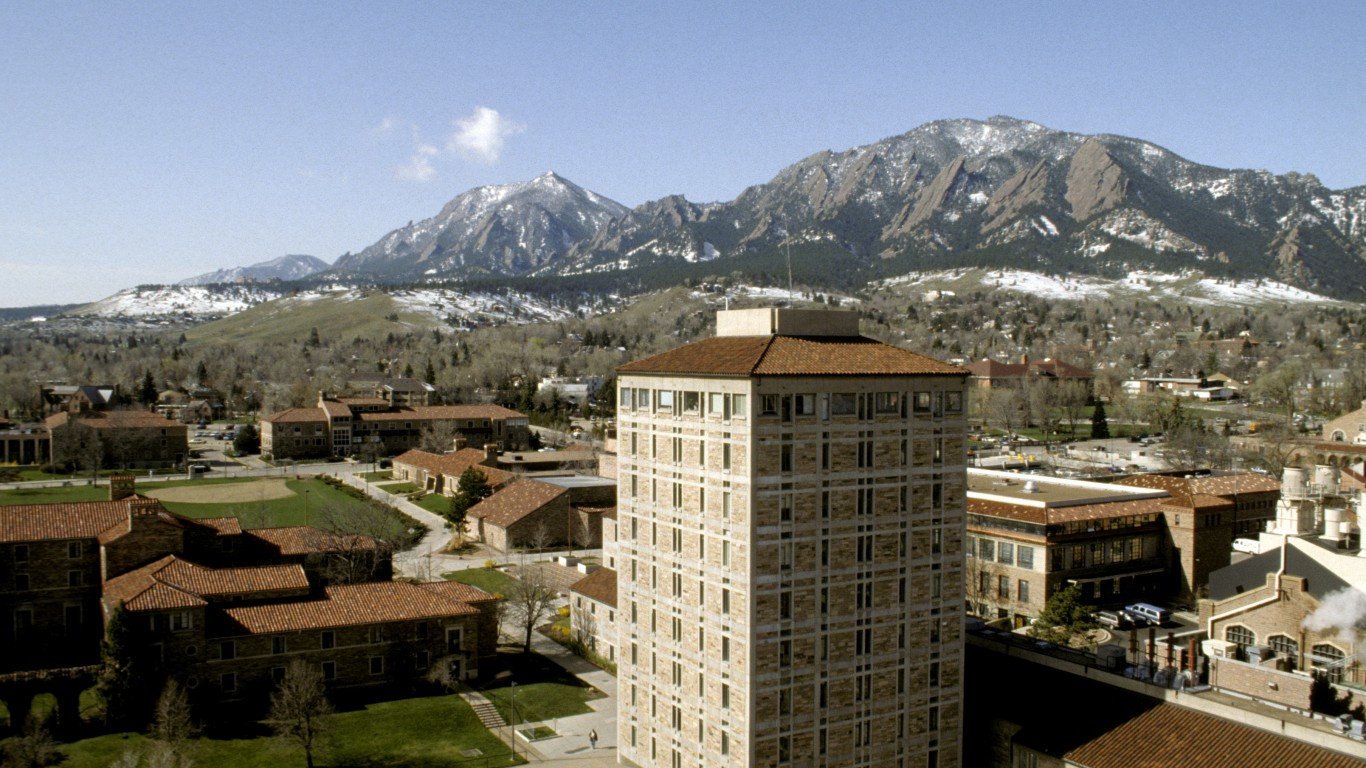
6. Colorado: Boulder
> Premature death rate: 212.0 per 100,000
> Adult obesity rate: 13.8%
> Rate of uninsured people under 65: 7.4%
> Median household income: $74,615
The adult residents of Boulder, Colorado feel better than those of any other metro area nationwide. Just 9.4% of adults in the Boulder area report being in suboptimal health — making it the only place in which fewer than 10.0% of adults feel this way. The area’s premature death rate of 212 residents per 100,000 is the second-lowest in the U.S. and by far the lowest in Colorado.
The Boulder area is one of the most active and fit places in the country. The metro area has a 13.8% obesity rate, the second-lowest nationwide, and less than half of the 28.0% nationwide obesity rate. Just 10.0% of adults in the Boulder area reported getting no physical activity in their free time, the lowest rate in the nation.
[in-text-ad]

7. Connecticut: Bridgeport-Stamford-Norwalk
> Premature death rate: 219.1 per 100,000
> Adult obesity rate: 21.4%
> Rate of uninsured people under 65: 9.9%
> Median household income: $90,123
The Bridgeport-Stamford-Norwalk area of Connecticut is one of the healthiest areas in the entire country due to a number of key health indicators. The metro area’s premature death rate of 219 per 100,000 residents is one of the lowest in the country and well below any other metro area in the state. Some 11.1% of Bridgeport area adults reported being in suboptimal health; each other metro area in the state had a rate at least one full percentage point higher.
Bridgeport area adults consistently display healthy habits. Very few adults in the area, just 10.4%, reported smoking. And just 18.9% reported getting no exercise during their leisure time. Both rates are the lowest in Connecticut. Adults in the metro area may be more likely to exercise because of heightened accessibility in the area. Some 96.0% of Bridgeport area residents said they had access to a place where they could work out — one of the highest rates nationwide.
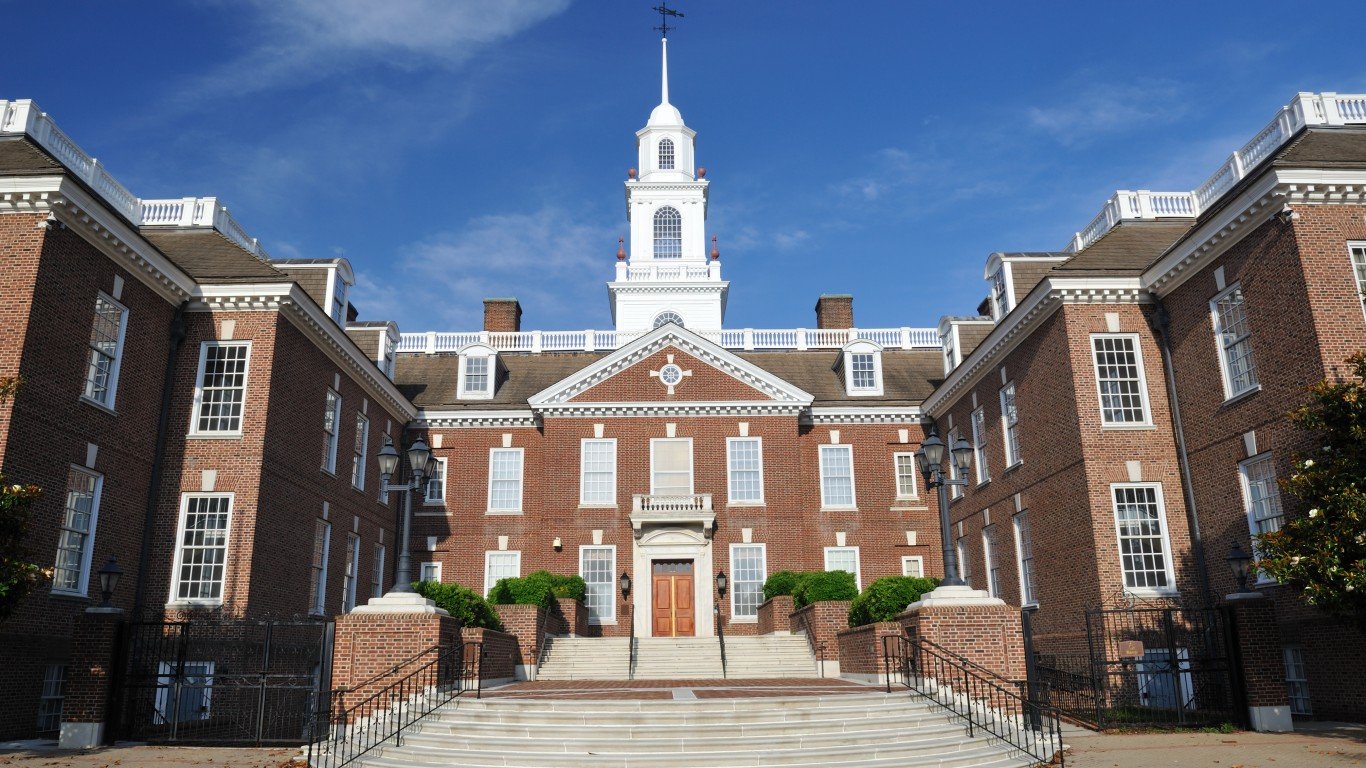
8. Delaware: Dover
> Premature death rate: 399.0 per 100,000
> Adult obesity rate: 33.6%
> Rate of uninsured people under 65: 7.6%
> Median household income: $54,140
Dover is the only place in Delaware large enough to qualify as a metropolitan statistical area, so it is the healthiest by default. However, Dover’s health indicators and outcomes do not compare favorably to most other metro areas in the U.S. More than one in three adults in the Dover area are obese, higher of the U.S. obesity rate as a whole. Dover area adults are also less likely to exercise than those in almost all other places. Less than 70% of adults in the Dover area said they engage in physical activity in their leisure time, one of the worst rates nationwide.
It is not just adults that struggle with their health in Dover. Infants are born with low birth weights more frequently — some 8.9% — in the Dover area than in most other places in the country. Infants born with low birth weights are more likely to face future medical challenges, like diabetes, heart disease, and developmental disabilities.
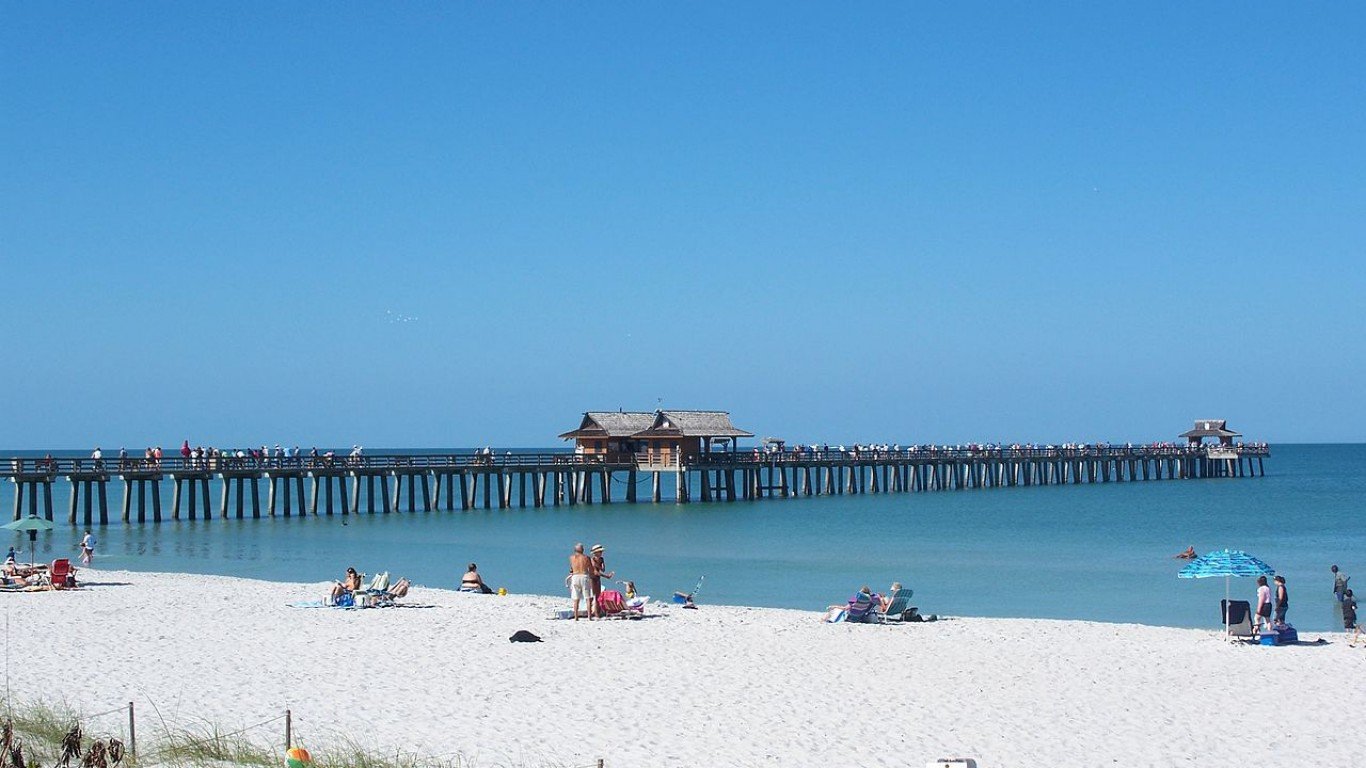
9. Florida: Naples-Immokalee-Marco Island
> Premature death rate: 216.6 per 100,000
> Adult obesity rate: 20.3%
> Rate of uninsured people under 65: 18.2%
> Median household income: $61,228
The Naples, Florida metro area has a much lower premature death rate than anywhere else in the state. Some 217 for every 100,000 of its residents die prematurely. The next closest rate in Florida is the Miami area with 279 per 100,000. Just 20.3% of adults in the Naples-Immokalee-Marco Island area are obese, the lowest rate in the state.
The relative health of the Naples metro area may be linked to its relative affluence. Of the 22 metropolitan statistical areas in Florida, just two have a median household income above the U.S. median of $57,617. Naples is the only area of Florida with a median household income over $60,000. This wealth likely affords residents the opportunity to take better care of themselves through improved diets and exercise opportunities.
[in-text-ad-2]

10. Georgia: Atlanta-Sandy Springs-Roswell
> Premature death rate: 326.5 per 100,000
> Adult obesity rate: 28.6%
> Rate of uninsured people under 65: 15.2%
> Median household income: $62,613
The Atlanta area is the only place in Georgia in which the average adult feels healthier than the average American adult. Some 15.7% of adults in Atlanta reported that they were in suboptimal health — the only part of Georgia in which the rate is below the U.S. rate of 16.0%. Residents also said they experienced an average of 3.5 mentally unhealthy days and 3.5 physically unhealthy days in the previous month. No other metro area in Georgia had either measure that was below the U.S. average of 3.8 and 3.7, respectively.
Adult residents of the Atlanta-Sandy Springs-Roswell area are also more likely to engage in certain healthy behaviors than adults in any other Georgia metropolitan statistical area. Some 15.7% of Atlanta area residents smoke, the only rate for any Georgia metropolitan area that falls below the U.S. average of 17.0%. Some 78.0% of adults said they got some exercise during their leisure time, the highest rate of any metro area in Georgia.

11. Hawaii: Urban Honolulu
> Premature death rate: 270.3 per 100,000
> Adult obesity rate: 22.2%
> Rate of uninsured people under 65: 4.4%
> Median household income: $80,513
Urban Honolulu beat out the only other metropolitan statistical area in Hawaii — Kahului-Wailuku-Lahaina — for the spot as the healthiest in the state, though both are among the healthiest in the U.S. Workers in Urban Honolulu are among the most likely to be employed, likely contributing to their overall good health, as economic instability and poverty are often linked with poor health outcomes. The unemployment rate in the area is just 2.2%, the second-lowest in the country.
The average adult in Urban Honolulu has 2.9 mentally unhealthy days and 2.9 physically unhealthy days per month — both averages are among the ten best in the country. Some 4.4% of Urban Honolulu residents under the age of 65 are uninsured, one of the lowest rates anywhere in the country and less than half of the nationwide rate of 11.0%. This high rate of insured residents likely allows those in Urban Honolulu to treat medical problems more quickly and effectively than in many other places nationwide.
[in-text-ad]

12. Idaho: Boise City
> Premature death rate: 276.4 per 100,000
> Adult obesity rate: 28.4%
> Rate of uninsured people under 65: 12.8%
> Median household income: $55,162
The Boise City metro area leads the state of Idaho in a number of key health outcomes. Its premature death rate of 276 per 100,000 is much lower than anywhere else in the state. The area also has the lowest percentage of adults who report being in either fair or poor health at 14.1%, though most other parts of Idaho also fall below the national rate of 16.0%. Some 18.5% of Boise City adults got at least some exercise during their leisure time, the best rate in the state and one of the better rates in the country.
As people continue to advance in age, it can become more difficult for them to manage their health. But Boise City Medicare enrollees, who are overwhelmingly above the age of 65, are among the best at treating certain conditions such as diabetes or dehydration before they become serious and require emergency treatment. There were just 24.7 preventable hospitalizations for every 1,000 Medicare enrollees in Boise City. That rate is the lowest in Idaho and just over half the U.S. rate of 49.0 per 1,000.
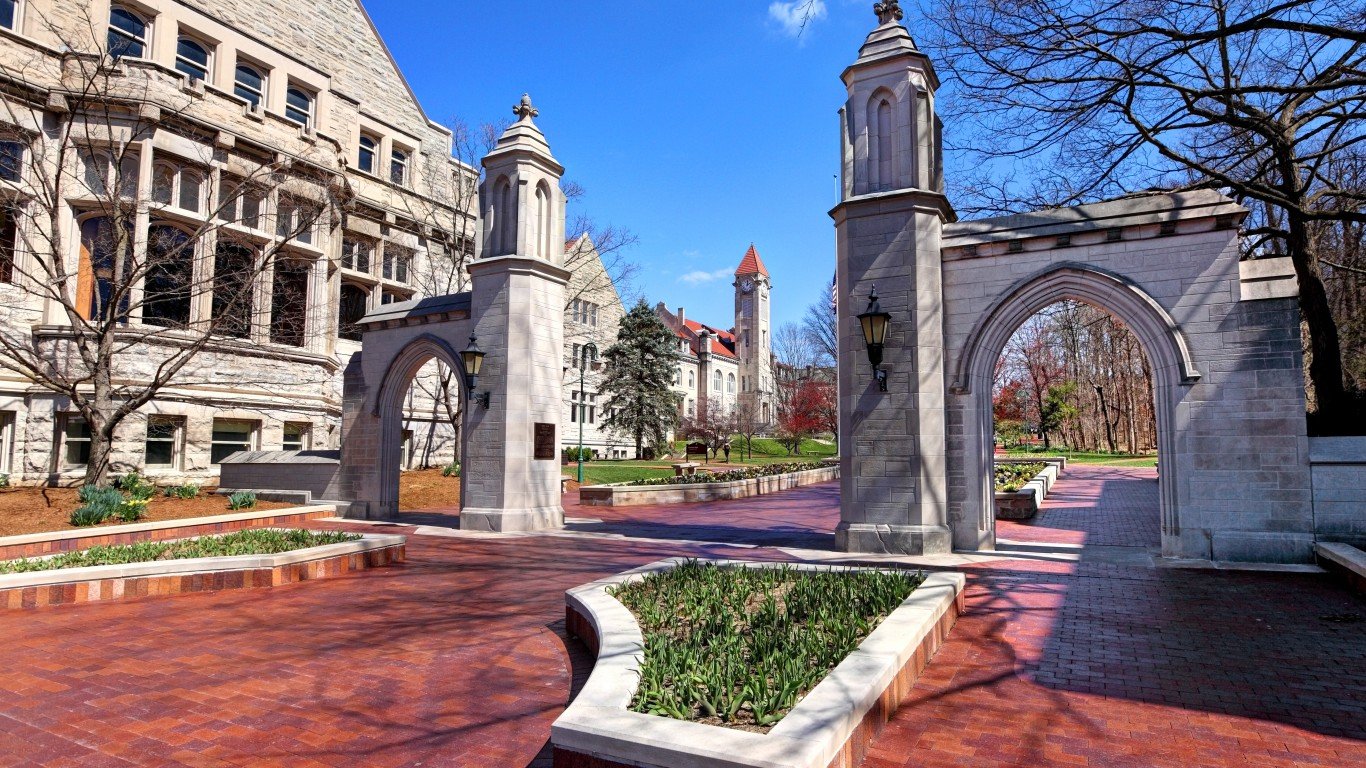
13. Illinois: Bloomington
> Premature death rate: 294.9 per 100,000
> Adult obesity rate: 29.0%
> Rate of uninsured people under 65: 5.5%
> Median household income: $61,320
At just 5.5%, the Bloomington, Illinois metro area has the lowest uninsured rate in the state, which is half the national rate of 11.0%. The uninsured rate is one of many strong economic indicators in the Bloomington area that can contribute to the overall health of the population.
Other than the Chicago metro area, Bloomington is the only place in Illinois with a median household income above the national median of $57,617.
The relatively high income may be partially attributable to the fact that the Bloomington area has the lowest unemployment rate in the state at 4.1%. Children in the area are much less likely to live in poverty than those anywhere else in Illinois. Just 12.4% of Bloomington-area children are impoverished. The next lowest rate in the state is 17.3%. Across the U.S., one in every five children is impoverished.

14. Indiana: Lafayette-West Lafayette
> Premature death rate: 330.8 per 100,000
> Adult obesity rate: 29.0%
> Rate of uninsured people under 65: 11.0%
> Median household income: $51,410
The Lafayette-West Lafayette metro area in Indiana has the lowest smoking rate in the state. However, at 17.5%, that smoking rate is 0.5 percentage points higher than the national average. Smokers are more likely to develop lung and heart problems. Pregnant women who use tobacco risk causing birth defects and giving birth to children with low birth weight.
Babies born with low birth weights are at a higher risk for a number of health issues. With a 6.9% low birth weight rate, babies born in the Lafayette-West Lafayette metro area are the least likely to be underweight compared to those born anywhere else in Indiana.
[in-text-ad-2]
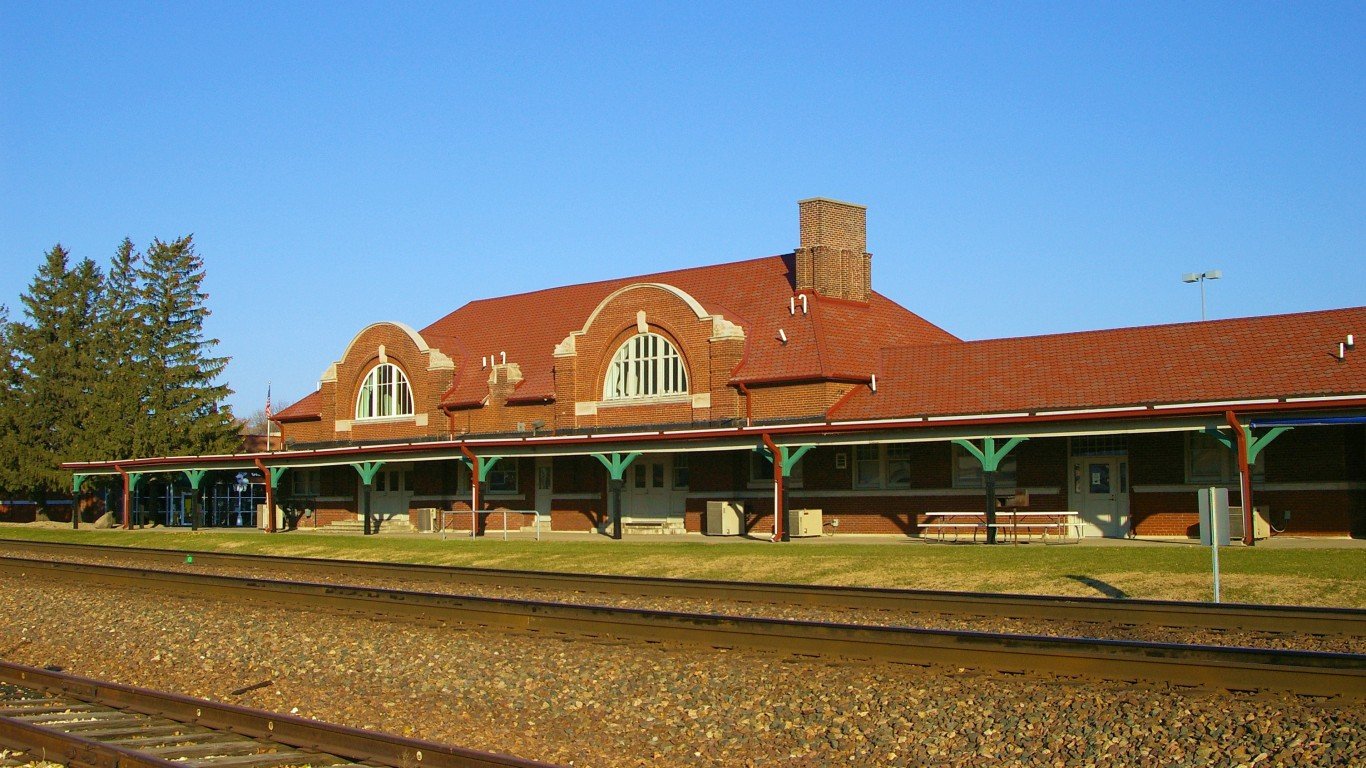
15. Iowa: Ames
> Premature death rate: 241.8 per 100,000
> Adult obesity rate: 27.0%
> Rate of uninsured people under 65: N/A
> Median household income: $53,371
The Ames, Iowa metro area is not just the healthiest place in the state, but also one of the healthiest in the country. The premature mortality rate of 242 deaths per 100,000 residents is among the lowest in the country and roughly two thirds of the national rate of 363 per 100,000.
Some 5.6% of babies born in the area have a low birthweight, one of the lowest rates in the nation. Being a teen mother increases the risk of having an underweight baby, and the Ames area has the second-lowest teen birth rate in the country. Just 4.5 out of every 1,000 births come from mothers age 15-19. By comparison, the next lowest rate in Iowa is more than twice as high at 9.6 per 1,000 births. The U.S. teen birth rate is six times higher than that in Ames, at 27.0 per 1,000 births.

16. Kansas: Manhattan
> Premature death rate: 251.3 per 100,000
> Adult obesity rate: 25.7%
> Rate of uninsured people under 65: N/A
> Median household income: $52,720
Residents of the Manhattan, Kansas metro area tend to feel better, both mentally and physically, than people in other areas of the state. In the last month, residents reported an average of 3.3 mentally unhealthy days and 3.1 physically unhealthy days. Only one metro area in Kansas had fewer physically unhealthy days among its residents and nowhere in the state had fewer mentally unhealthy days.
Just 5.8% of babies in the area are born with a low birth weight, the lowest rate in the state. Only a handful of places in the country have a lower percentage of underweight babies. Manhattan-area residents are also the least likely in Kansas to be obese. Just 25.7% of adults in the area are obese.
[in-text-ad]
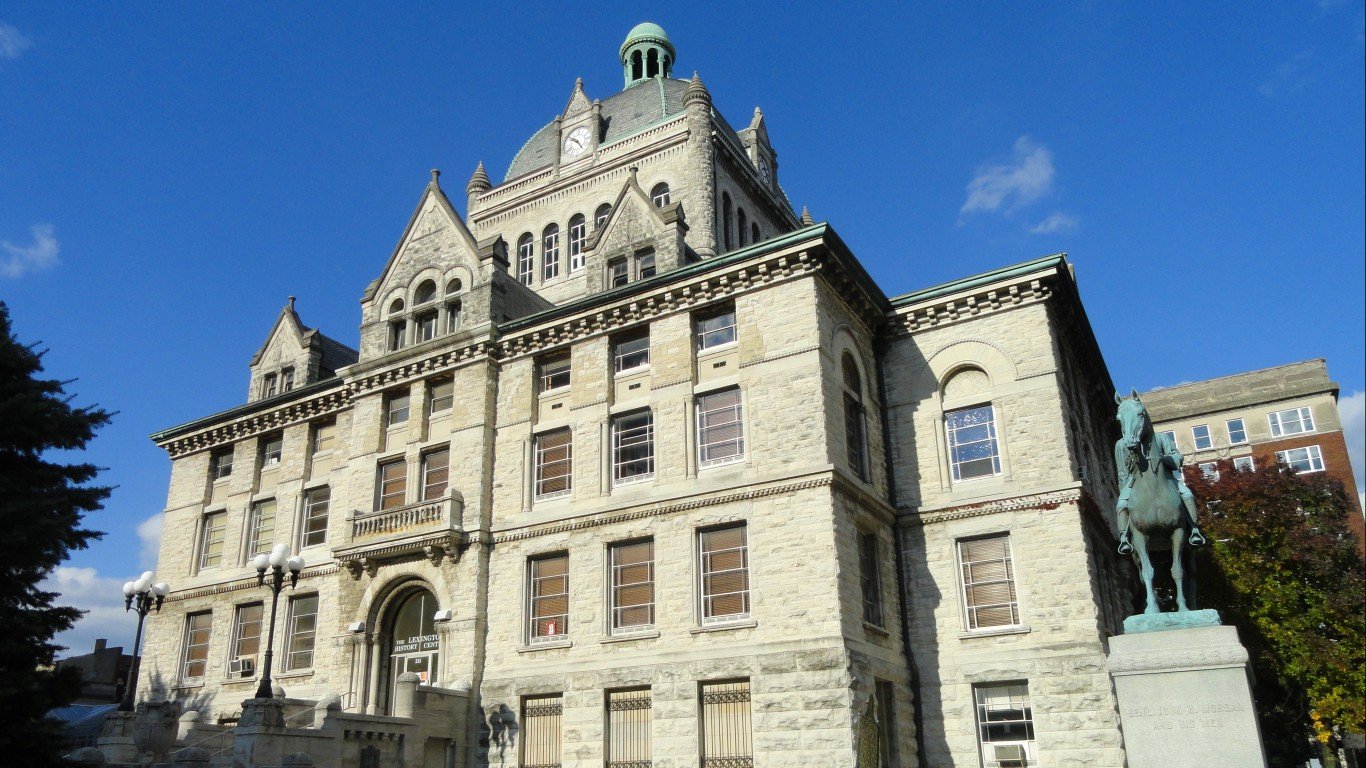
17. Kentucky: Lexington-Fayette
> Premature death rate: 388.3 per 100,000
> Adult obesity rate: 29.3%
> Rate of uninsured people under 65: 9.4%
> Median household income: $53,769
The Lexington-Fayette, Kentucky metro area far outpaces the other areas of the state when it comes to exercise accessibility. Some 90.7% of residents said they had a place to work out, by far the highest in the state. That could be one driving factor why just 22.8% of Lexington-Fayette area adults reported getting no physical activity in their leisure time. No other metro area in Kentucky fell below the U.S. rate of 23.0%. Some 29.3% of Lexington-Fayette adults are obese. While that obesity rate is higher than the national obesity rate of 28.0%, it is the only rate among Kentucky metro areas that falls below 30%.
Elderly Lexington-Fayette residents appear to have the best preventive care in the state. There were 49.0 preventable hospitalizations for every 1,000 area Medicare recipients — right in line with the national average. Rates were noticeably higher in all other metro areas in Kentucky.
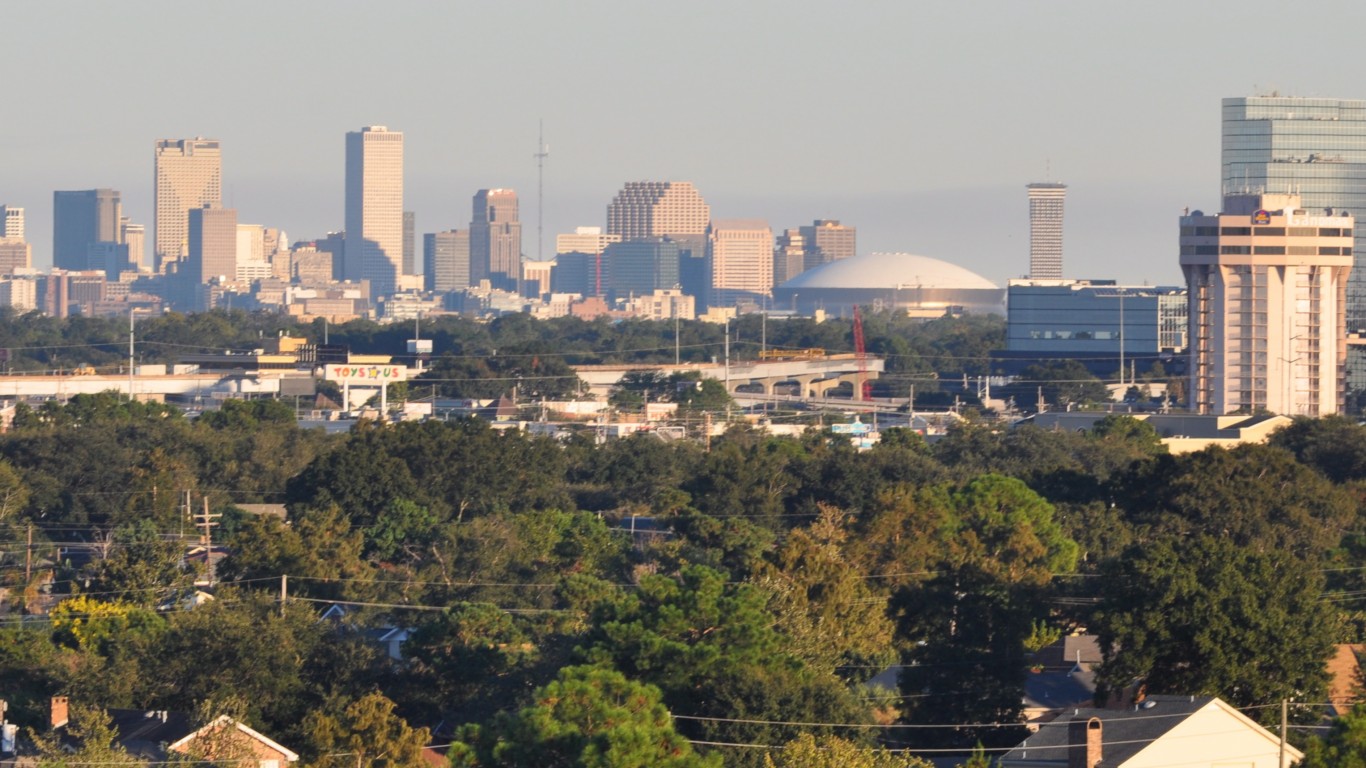
18. Louisiana: New Orleans-Metairie
> Premature death rate: 408.3 per 100,000
> Adult obesity rate: 33.4%
> Rate of uninsured people under 65: 13.6%
> Median household income: $48,804
The New Orleans metropolitan area leads the rest of Louisiana in a number of key health outcomes and indicators. The premature mortality rate of 408 premature deaths per 100,000 residents is the lowest in the state, though it surpasses the national rate of 363 per 100,000. The area also has the lowest obesity rate statewide at 26.8%. That may be due, at least in part, to the fact that 87.7% of the population of New Orleans and the surrounding area have access to exercise facilities. No other Louisiana metro area is above the national average of 83.0%.
Poverty and poor health are closely linked, so it should come as no surprise that the New Orleans-Metairie area, the healthiest place in Louisiana, also has the lowest poverty rate. Some 17.0% of area residents live in poverty. While that is above the national poverty rate of 14.0%, most places in the state have poverty rates of 20% and above.

19. Maine: Portland-South Portland
> Premature death rate: 288.3 per 100,000
> Adult obesity rate: 25.9%
> Rate of uninsured people under 65: 7.9%
> Median household income: $63,422
The Portland-South Portland area of Maine far outpaces the other two metro areas in Maine — Bangor and Lewiston-Auburn — in almost all important health measures. The Portland metro area reported an average of 288 premature deaths per 100,000 residents. The other two areas had more than 350 per 100,000. Those in the Portland area reported an average of 3.3 physically unhealthy days in the last month. Both other areas in Maine had more than the national average of 3.7 physically unhealthy days in that time frame.
Just 11.1% of adults in the Portland area, or about one in nine, reported being in either fair or poor health. That rate by far the lowest in the state and well below the national average of 16.0%. The teen birth rate in the area was also well below the rest of the state and national average. Just 12.9 out of every 1,000 births in the Portland-South Portland metro area were from teenage mothers — less than half the national rate of 27.0 per 1,000.
[in-text-ad-2]

20. Maryland: California-Lexington Park
> Premature death rate: 307.5 per 100,000
> Adult obesity rate: 34.2%
> Rate of uninsured people under 65: N/A
> Median household income: $78,195
The California-Lexington Park metro area in Maryland is the tenth-most affluent in the nation with a median household income of $78,195. This wealth gives the area’s residents a significant advantage over many other parts of the state and nation in terms of affording top-quality health care, healthy foods, and exercise facilities. More affluent areas also tend to be safer, which may be one reason why the violent crime rate is just 203 violent crimes per 100,000 residents — the lowest rate in the state and one of the lower nationwide violent crime rates.
The California-Lexington Park area also had the fewest mentally and physically unhealthy days per resident in Maryland over the last month, with 3.2 and 3.0, respectively. Some 11.3% of California-Lexington Park adults reported being in fair or poor health. Only a handful of other metro areas — none of which are in Maryland — had a lower rate.
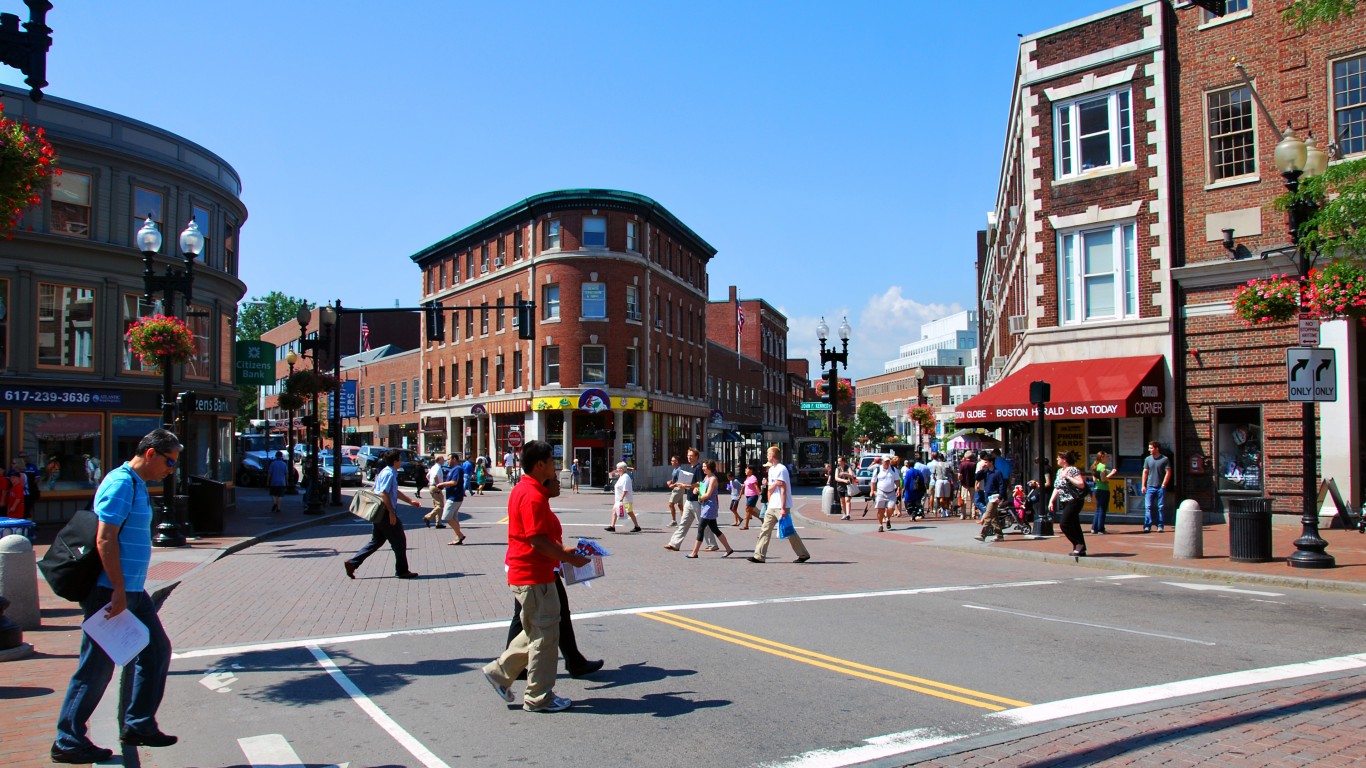
21. Massachusetts: Boston-Cambridge-Newton
> Premature death rate: 265.1 per 100,000
> Adult obesity rate: 23.6%
> Rate of uninsured people under 65: 3.5%
> Median household income: $82,380
Residents of the Boston-Cambridge-Newton area likely have a much easier time accessing medical care than anywhere else in Massachusetts. There are 111 primary care physicians and 109 dentists for every 100,000 area residents. Both rates are the highest in the state and among the highest in the country. It may also be easier for area residents to receive medical care because almost everyone in the Boston area has health insurance.
Just 3.5% of people in the Boston area are uninsured. While that is less than a third of the nationwide uninsured rate of 11.0%, all metro areas in Massachusetts for which there are data have an uninsured rate at or below 3.5%. This abundance of medical care may contribute to positive health outcomes. The area had just 265 premature deaths for every 100,000 residents, the lowest in the state and well below the national rate of 363 per 100,000.
[in-text-ad]
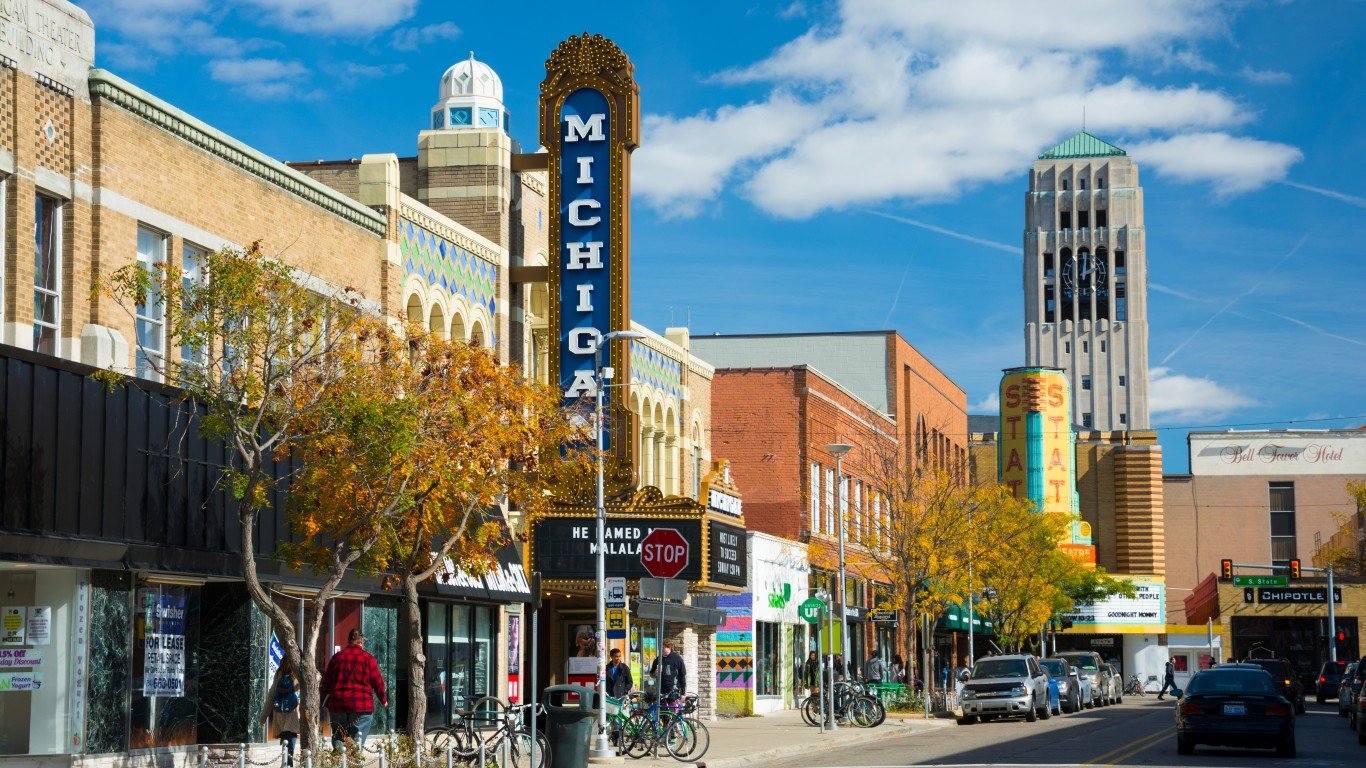
22. Michigan: Ann Arbor
> Premature death rate: 254.3 per 100,000
> Adult obesity rate: 23.9%
> Rate of uninsured people under 65: 5.7%
> Median household income: $65,601
Of the 14 metropolitan areas in Michigan, Ann Arbor is the only one in which the adult obesity rate is below the national average of 28.0%. Some 23.9% of Ann Arbor adults are obese, one of the country’s lowest rates. The Michigan metro area with the next lowest obesity rate is the Grand Rapids area, which is a full six percentage points higher.
Ann Arbor is also the most active part of Michigan as just 15.8% of adults got no exercise in their leisure time. Nowhere else in the state had a rate below 20%. The smoking rate in Ann Arbor of 12.8% also falls well below anywhere else in the state.
However, the area is not without its unhealthy behaviors. The excessive drinking rate in Ann Arbor and the surrounding area is 24.6%. That rate is the highest in the state and far beyond the 18.0% national excessive drinking rate.

23. Minnesota: Rochester
> Premature death rate: 227.1 per 100,000
> Adult obesity rate: 27.3%
> Rate of uninsured people under 65: 5.6%
> Median household income: $70,078
The title of healthiest city in Minnesota was hotly contested, as each of Minnesota’s metropolitan areas were among the healthiest in the nation. The Rochester, Minnesota metro area is the healthiest because it had, overall, the best health outcomes of any place in the United States. The average resident had just 2.7 physically unhealthy days in the last month, the lowest in the entire country.
The premature mortality rate in the Rochester area is 227 per 100,000 residents and just 11.0% of residents reported that they were in either fair or poor health. Both outcomes are among the top 10 in the nation. The area also had just 5.8% of births with low birth weights and 13.8% of adults smoke. Both measures were also among the nation’s best.

24. Mississippi: Hattiesburg
> Premature death rate: 469.8 per 100,000
> Adult obesity rate: 34.4%
> Rate of uninsured people under 65: 15.5%
> Median household income: $46,765
Though the Hattiesburg metro area is the healthiest place in Mississippi, it is one of the least healthy places in the U.S. overall. The only other two metro areas in the state, Gulfport-Biloxi-Pascagoula and Jackson, struggled with similar poor health indicators and fell just below Hattiesburg on the overall ranking of the healthiest areas, though all were near the bottom.
Some 29.9% of Hattiesburg area residents reported no leisure physical activity. That rate is well above the national average of 23.0%, but lower than the other metro areas in Mississippi. Hattiesburg area residents are relatively safe, as there are just 199 violent crimes per 100,000 residents, well below the national violent crime rate of 386 per 100,000 residents.
[in-text-ad-2]

25. Missouri: Columbia
> Premature death rate: 284.1 per 100,000
> Adult obesity rate: 28.3%
> Rate of uninsured people under 65: 8.0%
> Median household income: $52,752
Younger Columbia, Missouri-area residents are more likely to have health insurance than those in any other major metropolitan area in the state. Just 8.0% of people below 65 in the area have no health insurance. The area also allows for greater access to primary care physicians than any other part of Missouri. There are 111 primary care physicians for every 100,000 residents. The next highest rate in the state is 80 per 100,000.
Columbia is the most active metro area in Missouri. Just 20.3% of Columbia adults reported no leisure time physical activity, making it the only place in Missouri with an inactivity rate below the 23.0% national average. Perhaps as a result of this exercise habit, Columbia is also the least obese place in Missouri. Some 28.3% of Columbia adults are obese. That is a slightly higher rate than the U.S. obesity rate of 28.0%, but nowhere else in the state fell below a 30% obesity rate.

26. Montana: Missoula
> Premature death rate: 303.2 per 100,000
> Adult obesity rate: 22.7%
> Rate of uninsured people under 65: 12.2%
> Median household income: $46,550
Missoula is not just the most active metro area in Montana; its adult residents also tend to get more exercise than all but a handful of other metro areas nationwide. Just 15.1% of adults in the area got no physical activity. Some 91.8% of Missoula area residents have access to a place where they can get physical activity, which also far outpaces the rest of the state.
Better educated people have been shown to make better decisions for their health and Missoula is the most educated place in Montana. Some 78.8% of adults age 25-44 have some post secondary education, the next highest metro area in Montana is 67.9%. However, Missoula has the third-highest rate of excessive drinking in the country at 26.0%. The national average is 18.0%. This may be a factor behind why 42.7% of all driving deaths involved alcohol, compared to the national rate of 29.0%.
[in-text-ad]
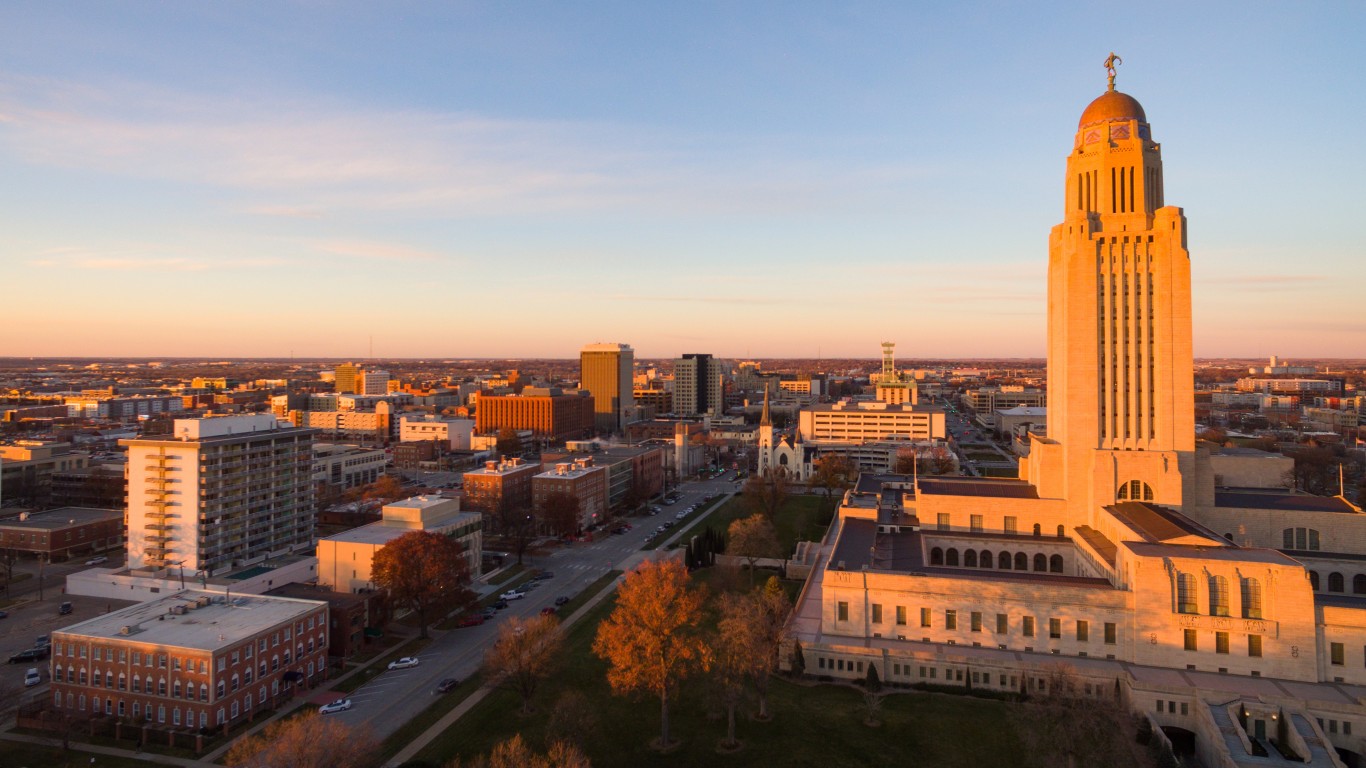
27. Nebraska: Lincoln
> Premature death rate: 274.5 per 100,000
> Adult obesity rate: 27.4%
> Rate of uninsured people under 65: 9.0%
> Median household income: $59,344
Lincoln, Nebraska residents have among the best health outcomes in the country. Just 11.1% of area adults reported being in either fair or poor health, well below anywhere else in Nebraska and one of the lowest rates in the country. The average resident also had just 2.8 physically unhealthy days in the last month — the fifth lowest rate of any metro area nationwide.
Lincoln area residents are more likely to take part in certain important healthy habits, and avoid some unhealthy ones, than residents in other Nebraska metro area residents. Nearly 82% of adults in the area get at least some exercise in their free time, the highest rate in the state. Lincoln also has the lowest rate of smokers in Nebraska. Some 14.3% of Lincoln residents smoke.

28. Nevada: Reno
> Premature death rate: 357.5 per 100,000
> Adult obesity rate: 21.5%
> Rate of uninsured people under 65: 13.9%
> Median household income: $58,056
Reno, Nevada is one of the thinnest metro areas in the country and by far the least likely to be obese in the state. Some 21.5% of Reno-area adults are obese, well below the 28.0% national obesity rate. The Reno area is also the most active in the state. Only 17.1% of adults in the area failed to exercise in their leisure time, well below the two other Nevada metro areas: Carson City and Las Vegas-Henderson-Paradise.
Reno-area adults also tend to feel better than those in other parts of Nevada. Some 15.6% of adults in the metro area reported being in suboptimal health, compared to the national rate of 16.0%. Both other Nevada metro areas are over 18%.

29. New Hampshire: Manchester-Nashua
> Premature death rate: 310.3 per 100,000
> Adult obesity rate: 28.1%
> Rate of uninsured people under 65: 8.1%
> Median household income: $76,254
The Manchester-Nashua area of New Hampshire is the only part of the state to qualify as a metropolitan area, so it had no competition for the designation of the healthiest city in New Hampshire. However, it is still one of the healthier metro areas in the U.S. The premature mortality rate of 310 premature deaths per 100,000 residents is well below the national average of 363 per 100,000.
The median household income of $76,254 makes Manchester-Nashua one of the most affluent metro areas in the country, with often makes staying healthy significantly easier. For example, wealthier people are more likely to b able to afford health insurance. Just 8.1% of residents under 65 are uninsured, compared to the national rate of 11.0%. The area also has an above average number of primary care physicians, dentists, and mental health providers per capita when compared to overall U.S. rates.
[in-text-ad-2]
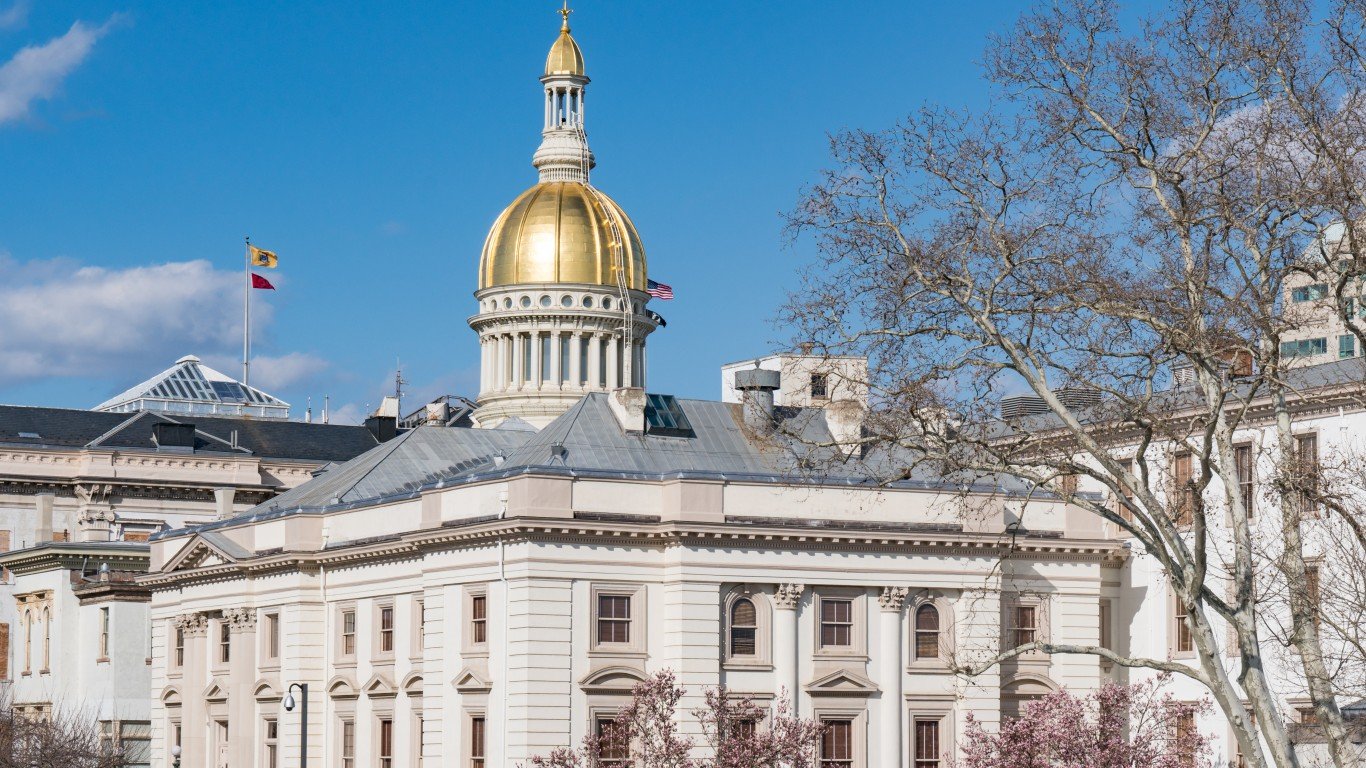
30. New Jersey: Trenton
> Premature death rate: 296.7 per 100,000
> Adult obesity rate: 25.2%
> Rate of uninsured people under 65: 9.6%
> Median household income: $77,650
Of the four metro areas in New Jersey — Trenton, Ocean City, Atlantic City-Hammond, and Vineland-Bridgeton — Trenton is the only one with a premature mortality rate below the U.S. rate of 363 early deaths for every 100,000 residents. Trenton’s rate is actually far below that, with 297 premature deaths per 100,000 residents.
The Trenton area’s adult residents are the least likely in New Jersey to be obese. Just 25.2% of Trenton adults are obese. That could be due in part to the fact that a large share of Trenton residents have a place to exercise. Some 97.5% of Trenton residents said they had a place to work out — the second-highest rate in the country.

31. New Mexico: Santa Fe
> Premature death rate: 292.1 per 100,000
> Adult obesity rate: 13.5%
> Rate of uninsured people under 65: 15.4%
> Median household income: $57,863
The Santa Fe metro area’s adult residents are less likely to be obese than those anywhere else in the entire country. Only 13.5% of area adults are obese, less than half the overall U.S. rate of 28.0%. The next closest metro area in the state, Albuquerque, has an obesity rate of 22.6%. This may be at least partially because 89.0% of adults in the area get at least some exercise in their free time. Only one other place in the country is more active.
Santa Fe is the only metro area in New Mexico in which the average adult resident is less likely to report being in suboptimal health than the average American adult. Some 14.6% of adults said they were in suboptimal health. The U.S. rate is 16.0%. There are likely a number of factors behind this, one of which may be the low smoking rate. Just 12.6% of Santa Fe adults smoke, well below all other metro areas in New Mexico, as well as the U.S. smoking rate of 17.0%.
[in-text-ad]
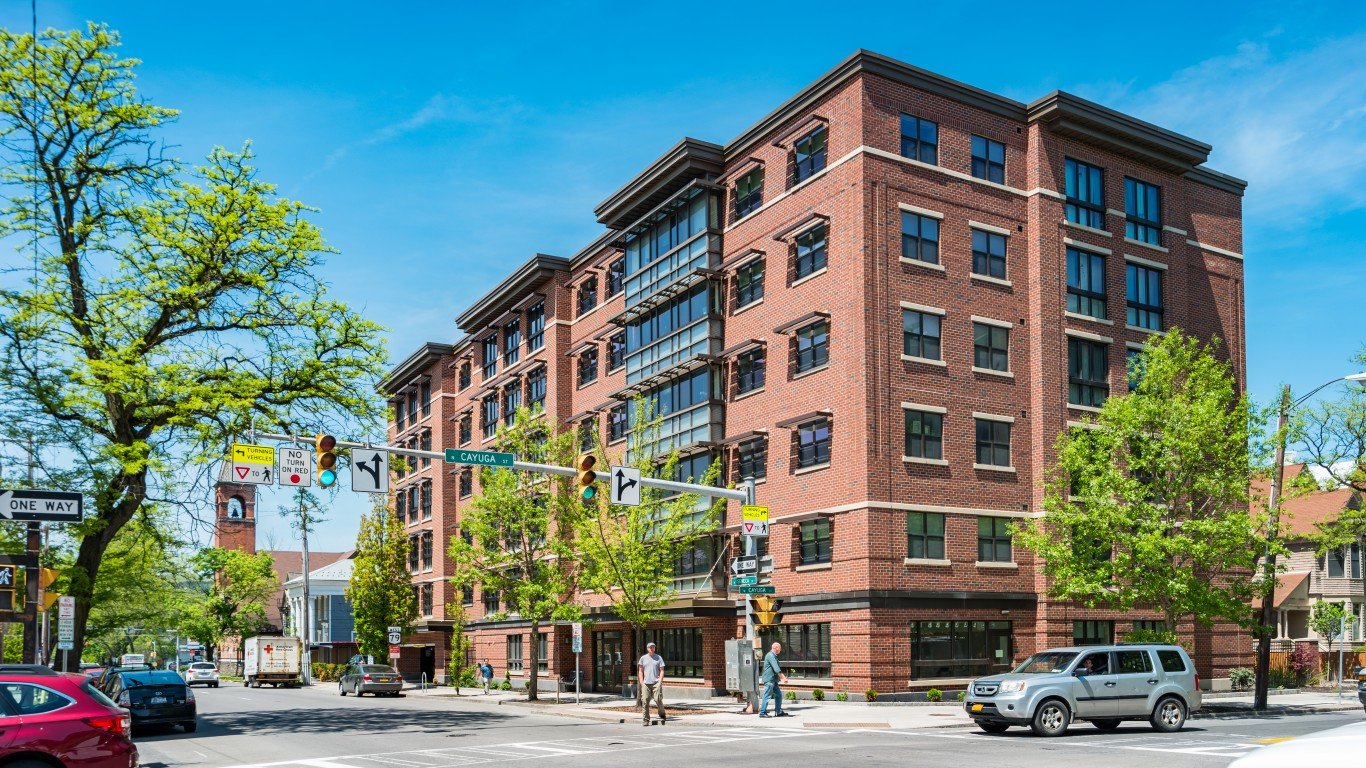
32. New York: Ithaca
> Premature death rate: 261.5 per 100,000
> Adult obesity rate: 24.4%
> Rate of uninsured people under 65: N/A
> Median household income: $56,349
Ithaca is by far the most active metropolitan area in New York. Some 20.2% of adults got no leisure time physical activity, making it the only place in the state with an inactivity rate below the national rate of 23.0%. Some 24.4% of Ithaca area adults are obese, nearly the lowest in the state and below the 28.0% national average.
Ithaca leads the rest of New York in several key health indicators regarding children. The city has the lowest rate of babies born with low birth weights in the state, at just below 6.6%. The national average is 8.0%. This may be partially attributable to the extremely low teen birth rate. Just 5.6 births per 1,000 come from mothers aged 15-19, which is the third-lowest rate in the country. The next lowest birth rate in the state is 12.3 births per 1,000 and the national average is 27.0 births per 1,000. Teen mothers are at a higher risk of giving birth to underweight children.

33. North Carolina: Raleigh
> Premature death rate: 264.4 per 100,000
> Adult obesity rate: 25.2%
> Rate of uninsured people under 65: 11.1%
> Median household income: $71,685
Eating right, exercising, and taking good care of oneself can often extend one’s life, but random accidents and injuries kill many Americans each year. Yet in the Raleigh, North Carolina area, those injuries are much more rare. There are just 45.0 fatal injuries in Raleigh for every 100,000 residents — the lowest rate in North Carolina and one of the lowest rates in the country. For comparison, the U.S. injury mortality rate is 65.0 deaths per 100,000 residents.
Healthcare, both emergency and preventive, can be a huge financial burden. More affluent areas are much better equipped to stay healthy and treat any health issues that emerge. Raleigh is a prime example of this. With a median household income of $71,685, Raleigh is by far the wealthiest area of North Carolina. The next highest median household income in the state is less than $60,000. This may be one of the reasons that a higher percentage of Raleigh’s under-65 population, 11.1%, is insured than anywhere else in the state.
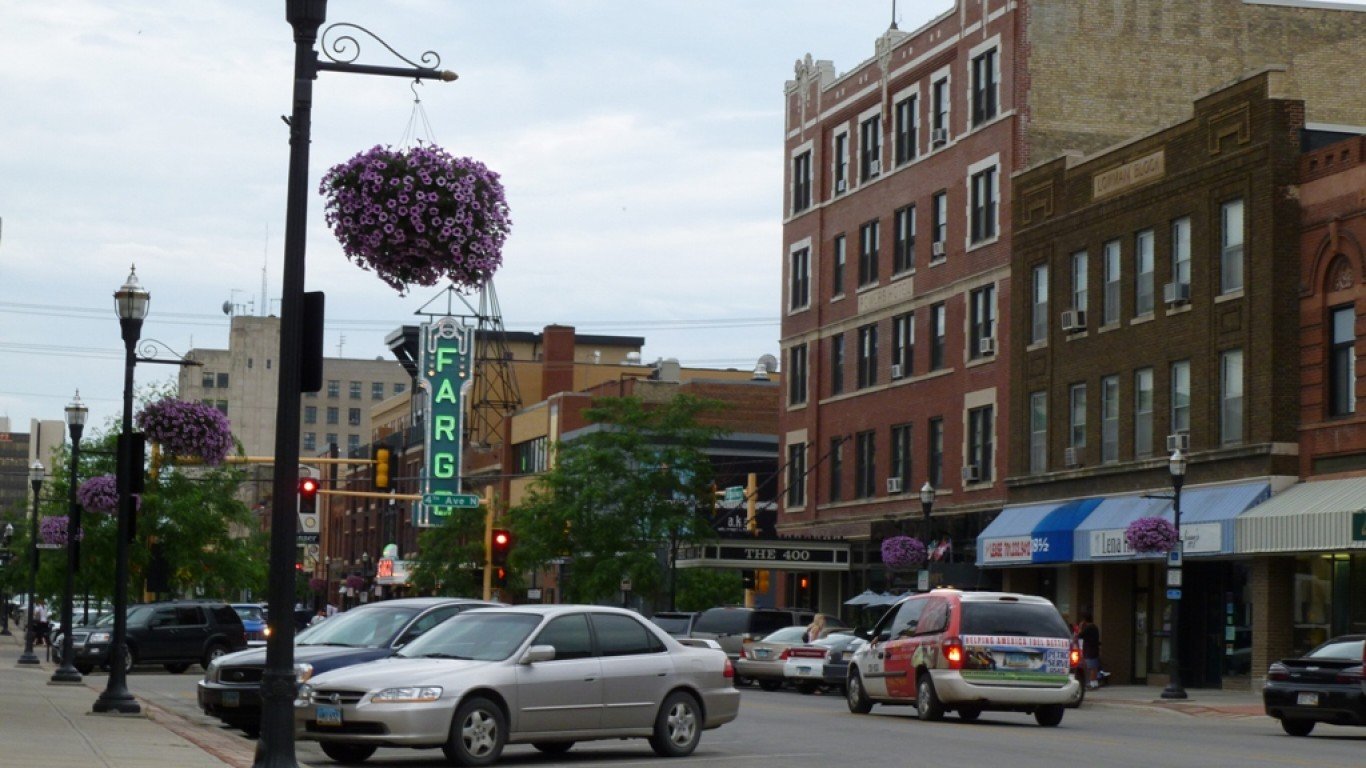
34. North Dakota: Fargo
> Premature death rate: 291.8 per 100,000
> Adult obesity rate: 29.3%
> Rate of uninsured people under 65: 7.0%
> Median household income: $60,009
Fargo, North Dakota-area residents were less likely to experience mentally and physically unhealthy days than almost anywhere else in the state. The average adult reported 2.8 mentally unhealthy days and 2.7 physically unhealthy days in the last month. Both of those averages are the second lowest of any metro area in the entire country and a full day less than the U.S. average.
Though the median household income of the Fargo area, $60,009, is slightly higher than the U.S. median of $57,617, residents are among the most likely to be insured and employed in the U.S. The uninsured rate for Fargo residents under 65 is 7.0%, the lowest in the state and four percentage points under the national average. The unemployment rate is just 2.4%, one of the lowest rates in the country and two percentage points below the national average.
[in-text-ad-2]

35. Ohio: Columbus
> Premature death rate: 359.4 per 100,000
> Adult obesity rate: 30.2%
> Rate of uninsured people under 65: 8.9%
> Median household income: $60,294
The premature mortality rate in Columbus, Ohio of 359 premature deaths per 100,000 residents makes it the only place in the state with a premature death rate better than the national rate of 363 deaths per 100,000 residents. Columbus residents also tend to feel healthier than other Ohioans. Some 15.1% of Columbus adults reported being in either fair or poor health, the lowest rate statewide.
Columbus adults also averaged the fewest number of physically unhealthy days in the last month, with 3.5. Columbus residents are likely healthier than those in other Ohio metro areas, possibly because they tend to be more affluent. The median household income of $60,294 is the highest in the state, meaning residents are better able to afford healthier food and medical treatment.

36. Oklahoma: Oklahoma City
> Premature death rate: 413.7 per 100,000
> Adult obesity rate: 31.8%
> Rate of uninsured people under 65: 14.3%
> Median household income: $55,065
None of the four metropolitan areas in Oklahoma — Oklahoma City, Enid, Tulsa, and Lawton — are healthier than the average American city. The Oklahoma City-area still holds major health advantages over the other three. While the area’s premature death rate of 414 deaths per 100,000 residents is well above the national rate of 363 per 100,000, it is still the lowest in the state by far.
The Oklahoma City metro area is also the most active place in the state. Some 27.5% of adults do not exercise, which is the lowest rate in the state but still beyond the U.S. average of 23.0%. Oklahoma City, as well as the other state metro areas, drink to excess less frequently than the average U.S. metro area. Just 13.6% of adults in Oklahoma City reported that they drank excessively, below the U.S. excessive drinking rate of 18.0%.
[in-text-ad]

37. Oregon: Corvallis
> Premature death rate: 228.6 per 100,000
> Adult obesity rate: 24.4%
> Rate of uninsured people under 65: N/A
> Median household income: $55,459
The rate of underweight births in an area is often a good indicator for the health of a population and the quality of regional medical care. Babies born in the Corvallis, Oregon metropolitan area are the least likely to be born underweight of any area in the U.S. Just 5.4% of Corvallis-born babies are below the 2,500-gram (about 5.5-pound) threshold that is considered healthy. The U.S. average is 8.0%. Babies born at a healthy weight are less likely to face complications as a newborn, as well as other health challenges in the future.
Corvallis has a premature death rate of 229 deaths per 100,000 residents, the lowest in the state of Oregon and lower than all but a handful of other places in the country. Only 79.1% of Corvallis residents reported having a place to exercise, which is below the national rate of 83.0%. However, that did not stop them from getting physical activity. Some 11.1% of Corvallis area adults got no leisure time activity, the third-lowest rate nationwide and by far the lowest in Oregon.

38. Pennsylvania: State College
> Premature death rate: 216.5 per 100,000
> Adult obesity rate: 29.3%
> Rate of uninsured people under 65: 6.6%
> Median household income: $60,266
The State College, Pennsylvania area has the third lowest premature death rate in the U.S., with 217 early deaths per 100,000 residents. The next lowest metro area in Pennsylvania, Lancaster, has a rate of 289 early deaths per 100,000 residents.
State College area residents are much more active than those in the rest of Pennsylvania. Just 17.3% of adults in the area got no physical activity in their leisure time. By comparison, all other major metropolitan areas had an inactivity rate above 22.0%.
Babies born in the State College area are much less likely to be born underweight than those other in other metro areas in the state and country. The low birth weight percentage in State College is 5.9%. The next lowest rate in Pennsylvania is 7.0% and the U.S. rate is 8.0%.
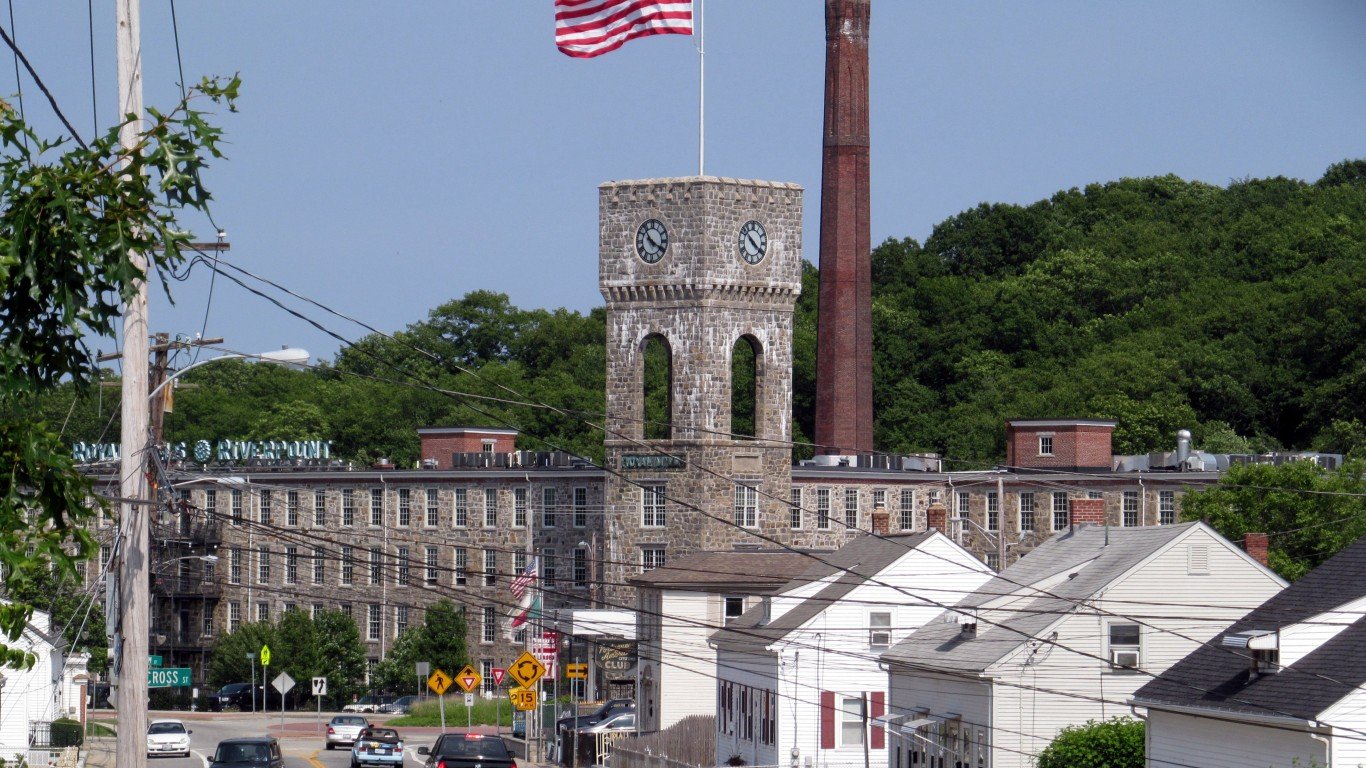
39. Rhode Island: Providence-Warwick
> Premature death rate: 314.8 per 100,000
> Adult obesity rate: 27.9%
> Rate of uninsured people under 65: 6.4%
> Median household income: $61,948
The Providence-Warwick area is the only part of Rhode Island to qualify as a major metropolitan area. It still stacks up favorably compared to the average American metro area. The premature mortality rate of 315 deaths per 100,000 residents is significantly better than the U.S. rate of 363 deaths per 100,000 residents.
The Providence area has an obesity rate of 27.9%, just below the U.S. obesity rate of 28.0%. The smoking rate in the area, 16.2%, is also just slightly lower than the U.S. rate, 17.0%. Adults in the Providence area tend to feel better than the average American adult. Some 14.5% of adults in the area feel that they are in either fair or poor health, whereas 16.0% of American adults feel the same.
[in-text-ad-2]
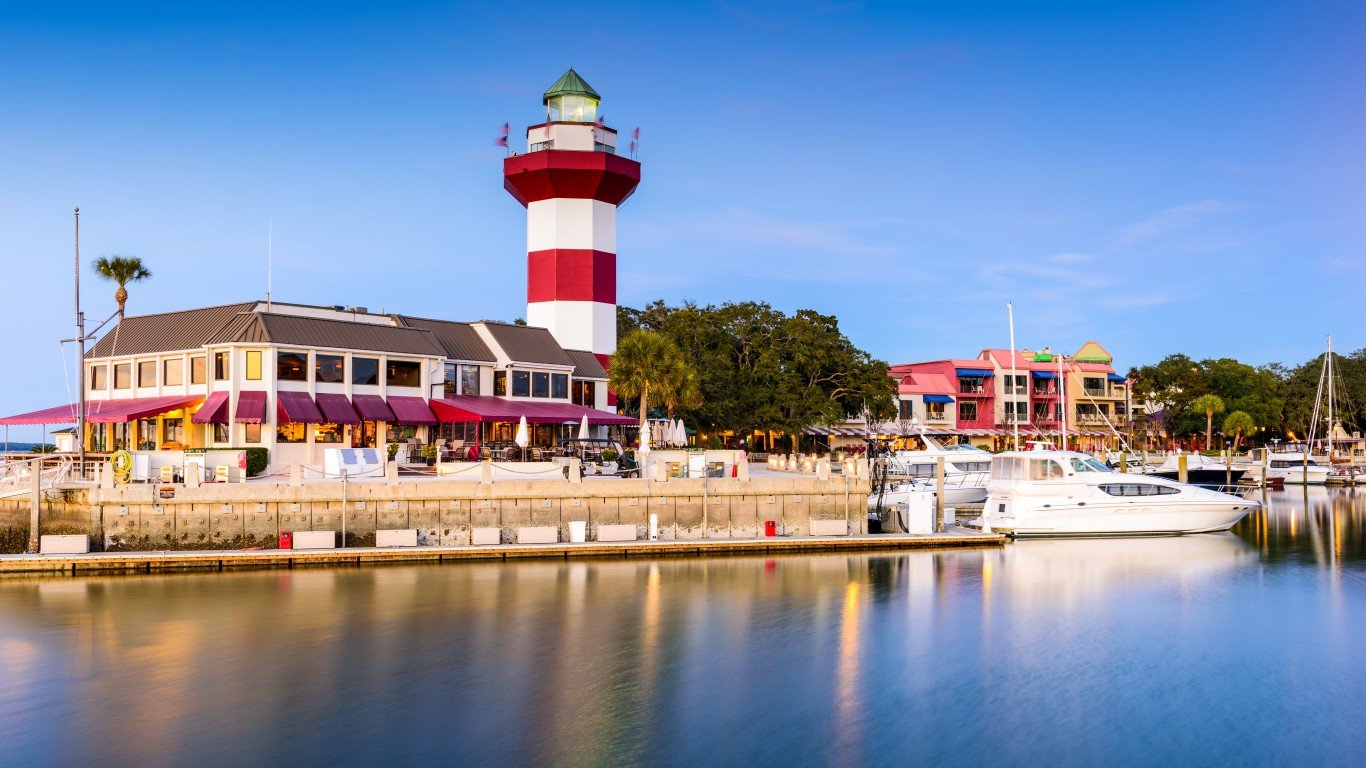
40. South Carolina: Hilton Head Island-Bluffton-Beaufort
> Premature death rate: 273.3 per 100,000
> Adult obesity rate: 25.0%
> Rate of uninsured people under 65: 14.7%
> Median household income: $63,756
Of the eight major metropolitan areas of South Carolina, the Hilton Head Island-Bluffton-Beaufort area is the only one which ranks as one of the healthier places in the country. The area also has the lowest premature mortality rate by a significant margin. Just 273 residents per 100,000 died prematurely. The next lowest rate was Charleston with 349 deaths per 100,000 residents.
The average Hilton Head Island area resident had 3.5 physically unhealthy days in the last month, making it the only area of South Carolina with fewer than 3.7, the national average. A quarter of Hilton Head Island area residents are obese, making it the only place in South Carolina with an obesity rate below the 28.0% national average.
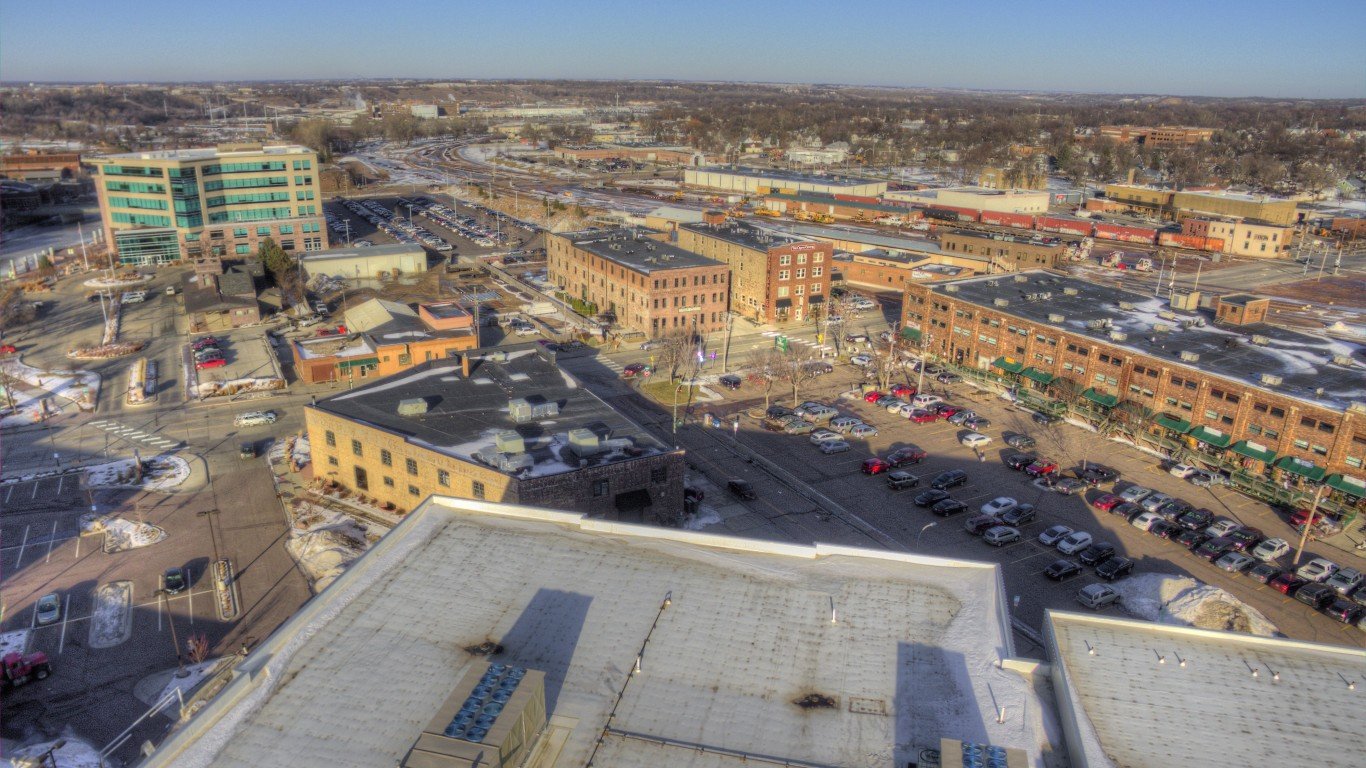
41. South Dakota: Sioux Falls
> Premature death rate: 287.1 per 100,000
> Adult obesity rate: 30.1%
> Rate of uninsured people under 65: 7.9%
> Median household income: $63,931
Sioux Falls and Rapid City are the only two metro areas in South Dakota and both are among the healthiest in the nation. Sioux Falls is the healthiest in the state Just 10.0% of adults reported being in either fair or poor health, the second lowest of all U.S. metro areas. Sioux Falls adults also had just 2.6 mentally unhealthy days in the last month, lower than all other metro areas nationwide.
However, Sioux Falls struggles with some health factors that can be detrimental to long-term wellbeing. The adult obesity rate is over 30%, which is above the U.S. average of 28.0%. Sioux Falls adults also tend to drink excessively. Some 19.8% of area adults reported excessive drinking, which is more than the 18.8% in Rapid City, as well as the 18.0% excessive drinking rate in the U.S. as a whole.
[in-text-ad]

42. Tennessee: Nashville-Davidson–Murfreesboro–Franklin
> Premature death rate: 375.0 per 100,000
> Adult obesity rate: 31.9%
> Rate of uninsured people under 65: 11.1%
> Median household income: $60,030
The Nashville metro area reported 375 premature deaths per 100,000 residents. While that is higher than the U.S rate of 363 early deaths per 100,000 residents, the Nashville area is the only place in Tennessee with a premature death rate less than 400 premature deaths per 100,000 residents.
Having a strong economic foundation is a crucial component to maintaining health, and the Nashville area is by far Tennessee’s most affluent. The metro area has a median household income of $60,030, well above any other area of the state. It also has the state’s lowest unemployment rate at 2.9%.

43. Texas: Austin-Round Rock
> Premature death rate: 253.7 per 100,000
> Adult obesity rate: 24.3%
> Rate of uninsured people under 65: 14.8%
> Median household income: $71,000
The residents of the Austin-Round Rock area take better care of themselves than any other major metro area in Texas. It has the lowest smoking rate in the state at 13.5%, as well as the lowest rate of adults who get no physical exercise during their free time. Some 17.3% of Austin area adult residents say they get no leisure time physical activity, while every other metro area in Texas has at least one in five adults that get no exercise.
Some 14.4% of Austin-Round Rock adult residents reported that they are in either fair or poor health, making it the only part of Texas in which the adult population feels better than the average U.S. metro area. Nationwide, 16.0% of people report being in fair or poor health. This may be partially due to the fact that Austin area adults are the least likely to be obese statewide.

44. Utah: Logan
> Premature death rate: 233.4 per 100,000
> Adult obesity rate: 24.5%
> Rate of uninsured people under 65: 9.8%
> Median household income: $57,414
The Logan area is the second-healthiest metro area in the country, just ahead of the Provo-Orem area of Utah. In fact, all five metro areas in Utah — which includes St. George, Ogden-Clearfield, and Salt Lake City — are among the healthiest in the U.S. For instance, the Logan area has the fifth-lowest smoking rate in the entire country, but it has one of the higher rates in the state. Even though the Logan smoking rate is 8.6%, nearly half the U.S. rate of 17.0%, three of the other four Utah metro areas have lower smoking rates.
Logan is the healthiest place in Utah largely because it has the lowest premature mortality rate in the state with 233 premature deaths per 100,000 residents. That is significantly below the U.S. rate, which is 363 premature deaths per 100,000 residents. Logan also has the lowest rate of people who report being in either fair or poor health in the state with just 10.8%, one of the lowest rates in the country.
[in-text-ad-2]
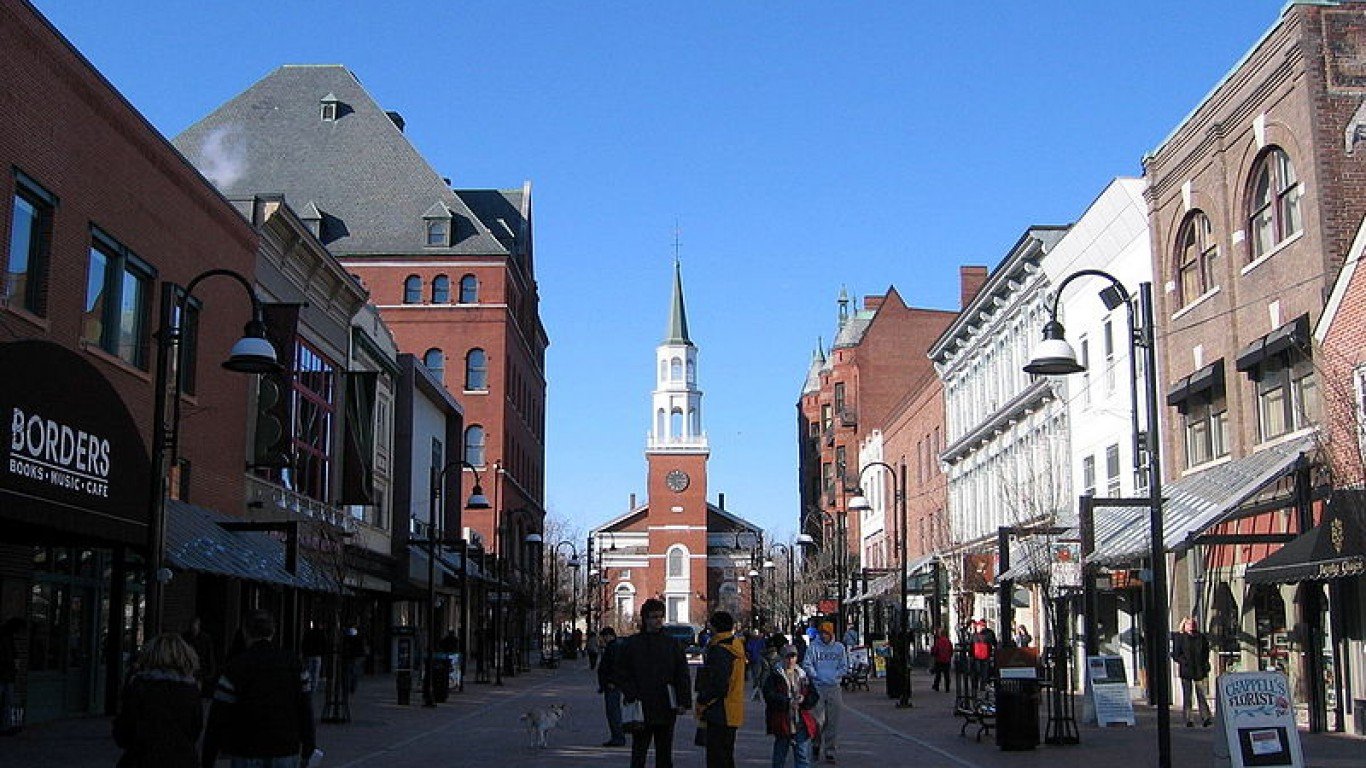
45. Vermont: Burlington-South Burlington
> Premature death rate: 275.6 per 100,000
> Adult obesity rate: 21.7%
> Rate of uninsured people under 65: 4.2%
> Median household income: $66,367
The Burlington-South Burlington area of Vermont is the only part of the state to qualify as a major metropolitan area, so it is the healthiest by default. However, it is still one of the healthiest places in the entire U.S. Just 10.5% of residents reported being in suboptimal health, the fifth-lowest rate in the country and well below the national rate of 16.0%.
Burlington-South Burlington is one of the most fit and active places in the U.S. Just 17.5% of area adults got no physical activity in their leisure time, which is one of the lower rates among all major metro areas. The area also has a lower proportion of obese adults than all but a small share of U.S. metro areas. At 21.7%, the Burlington obesity rate is well below the U.S. obesity rate of 28.0%.

46. Virginia: Charlottesville
> Premature death rate: 268.4 per 100,000
> Adult obesity rate: 26.1%
> Rate of uninsured people under 65: 9.7%
> Median household income: $62,523
Just 12.0 out of every 1,000 babies born in Charlottesville, Virginia are born to teenage mothers. That is by far the lowest teen birth rate in the state and one of the lowest in the country. The U.S. teen birth rate is more than twice as high at 27.0 per 1,000 births. Low teen birth rates indicate that fewer babies in the area will face certain early health complications associated with young mothers, as well as more uncertain financial futures.
Charlottesville also has some notable positive health factors for elderly residents as well. There were just 33.4 preventable hospitalizations per 1,000 Medicare enrollees in the area, the lowest in the state. This indicates that Medicare enrollees, who are almost all over 65, treated minor health issues before they became more serious and required hospitalization.
[in-text-ad]

47. Washington: Seattle-Tacoma-Bellevue
> Premature death rate: 265.2 per 100,000
> Adult obesity rate: 25.1%
> Rate of uninsured people under 65: 8.7%
> Median household income: $78,612
Adult residents of the Seattle-Tacoma-Bellevue area of Washington tend to have fewer illnesses, both mental and physical, than any other part of the state. Metro area residents had an average of 3.4 mentally unhealthy days and 3.2 physically unhealthy days in the last month. Both are the lowest averages in the state and among the lowest in the entire country. The Seattle area also has a lower rate of smokers than anywhere else in Washington. Just 11.3% of adults in the area smoke.
Health and poverty are closely linked, and more affluent areas tend to have much better health indicators and outcomes. The median household income in the Seattle area, $78,612, is far higher than anywhere else in the state. The area is also tied with Wenatchee for the lowest poverty rate in the state at 9.6%.

48. West Virginia: Morgantown
> Premature death rate: 348.7 per 100,000
> Adult obesity rate: 31.0%
> Rate of uninsured people under 65: 9.1%
> Median household income: $50,120
Morgantown, West Virginia has a premature mortality rate of 349 deaths per 100,000 residents. That is the lowest in the state and slightly below the U.S. rate of 363 deaths per 100,000 residents. All other metro areas in West Virginia have a premature death rate over 400 deaths per 100,000 residents.
All of West Virginia’s metropolitan areas have an obesity rate above the national rate of 28.0%, but Morgantown is the closest to it. Some 31.0% of Morgantown adults are obese. In all other areas of the state, at least 35% of adults are obese. Some 25.6% of Morgantown area adults get no leisure time exercise. That is the lowest rate in the state, but still beyond the U.S rate, which is 23.0%.
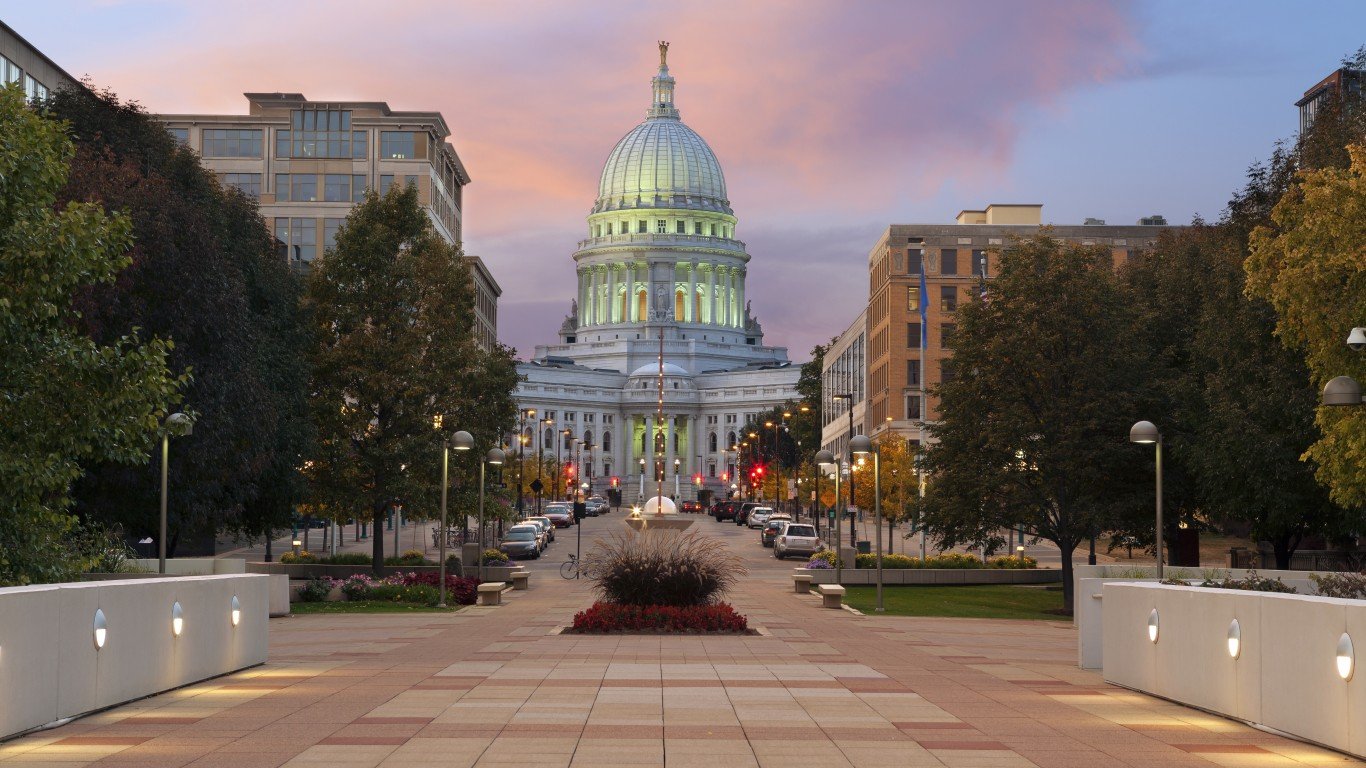
49. Wisconsin: Madison
> Premature death rate: 244.7 per 100,000
> Adult obesity rate: 26.0%
> Rate of uninsured people under 65: 5.5%
> Median household income: $68,497
While the Madison metropolitan area is the healthiest area in Wisconsin, it has one major issue that could cause serious health problems down the road: excessive drinking. Some 28.7% of adults in the area drink alcohol to excess, the highest rate in the nation. Excessive drinking can damage internal organs and cause a number of diseases. However, excessive drinking is income dependent so those who drink excessively can also typically afford healthy foods and adequate medical care.
Despite the high drinking rate, adults in the Madison area are more likely to engage in other healthy behaviors than all other Wisconsin metropolitan areas. Just 13.3% of Madison area adults smoke and only 17.1% get no leisure time physical activity. Both are the lowest rate in the state. The Madison area also has the state’s lowest obesity rate at 26.0%.
[in-text-ad-2]

50. Wyoming: Cheyenne
> Premature death rate: 359.7 per 100,000
> Adult obesity rate: 30.5%
> Rate of uninsured people under 65: 10.4%
> Median household income: $62,221
Detailed findings & methodology:
Cheyenne and Casper are the only two metropolitan areas in the state of Wyoming. Cheyenne leads Caper in a number of key health factors and outcomes. The area’s adults had an average of 3.5 days of poor mental health and 3.5 days of poor physical health in the last month. Casper’s averages fell in line with the U.S. rates, which are 3.8 mentally unhealthy days and 3.7 physically unhealthy days.
While not commonly associated with negative health impacts, people who drive to work for a long time each day are more likely to be obese and less likely to exercise. Cheyenne leads Wyoming, and the entire country, in the percentage of commuters who drive alone to work for 30 or more minutes. Just 7.3% of Cheyenne area residents have a solo commute longer than a half hour.
To determine the healthiest city in each state, 24/7 Wall St. made an index, ranking each of America’s 382 metropolitan areas based on health outcomes, such as the premature mortality rate, the number of physically and mentally unhealthy days in the last month, and the percentage of adults who feel they are in fair or poor health. The index also accounted for health factors, such as the rate of adults who got no exercise, the obesity rate, and the percentage of people under 65 that are uninsured in a given area.
Over the last two years, the premature mortality rate increased noticeably from 333 premature deaths per 100,000 residents to 363 premature deaths per 100,000 residents. County Health Rankings & Roadmaps noted that drug overdose deaths and other injuries “heavily influenced the rise in premature death.” The U.S. is struggling with an opioid epidemic, which may be one reason why the premature death rate increased the most among people aged 15-44. However, it is difficult to determine how many deaths are linked to overdoses from drugs like opioids, largely because overdose deaths are often listed as accidental deaths and not specifically noted as overdoses.
In 11 states, there are no metropolitan areas that are healthier than the average American metro area. Six of those states — Mississippi, Louisiana, Kentucky, Tennessee, Arkansas, and Alabama — are located in the Southeastern U.S. The other five — Oklahoma, West Virginia, Delaware, Ohio, and Nevada — are scattered across the country.
Another indicator of health outcomes in a given area is diversity. When speaking with 24/7 Wall St., County Health Rankings & Roadmaps associate researcher and community coach Justin Rivas said that “there is a connection to poorer health outcomes and segregated communities in urban areas.” He added that cities in the Midwest, South, and East Coast are more segregated than they are on the West Coast.
Hattiesburg, Mississippi was the least healthy place that ranked as the healthiest in its state. Out of 382 U.S. metro areas, it ranked 345th, with a high premature mortality rate of 470 early deaths per 100,000 residents. The San Jose-Sunnyvale-Santa Clara, California area is the healthiest in the state and the country. It has the lowest premature mortality rate of 196 premature deaths per 100,000 residents.
For the most part, the healthiest city in each state changes very little year over year. Just five states had different healthiest cities in 2017 and 2018 — Indiana, Louisiana, Mississippi, South Dakota, and Utah.
Many of the healthiest places in each state are also home to large colleges and universities. Metro areas like Columbia, Missouri, Lincoln, Nebraska, and Boulder, Colorado all have flagship state universities. These places have an influx of younger adults who are more likely to have high levels of educational attainment and higher salaries — both indicators of healthier populations as a whole.
To identify the 25 healthiest cities, 24/7 Wall St. reviewed all U.S. metropolitan statistical areas. The index rankings are based on overall health outcomes, a weighted composite of length of life, quality of life, and overall health factors. The data came from County Health Rankings & Roadmaps, a collaboration between the University of Wisconsin Population Health Institute and the Robert Wood Johnson Foundation. The health factors component is itself a weighted composite of healthy behaviors, clinical care, social and economic factors, and physical environment measures. Median household income figures and poverty rates came from the Census Bureau’s 2016 American Community Survey.
Essential Tips for Investing: Sponsored
A financial advisor can help you understand the advantages and disadvantages of investment properties. Finding a qualified financial advisor doesn’t have to be hard. SmartAsset’s free tool matches you with up to three financial advisors who serve your area, and you can interview your advisor matches at no cost to decide which one is right for you. If you’re ready to find an advisor who can help you achieve your financial goals, get started now.
Investing in real estate can diversify your portfolio. But expanding your horizons may add additional costs. If you’re an investor looking to minimize expenses, consider checking out online brokerages. They often offer low investment fees, helping you maximize your profit.
Thank you for reading! Have some feedback for us?
Contact the 24/7 Wall St. editorial team.
 24/7 Wall St.
24/7 Wall St. 24/7 Wall St.
24/7 Wall St. 24/7 Wall St.
24/7 Wall St.
